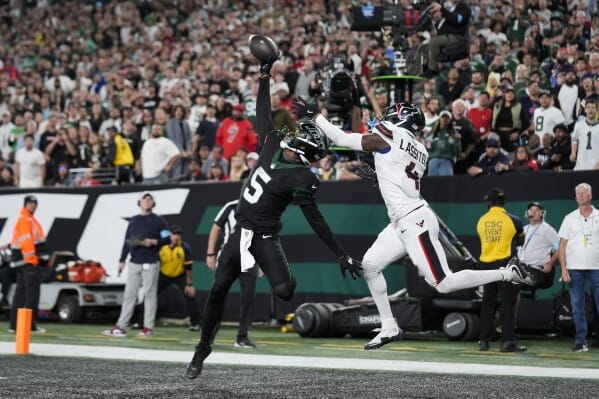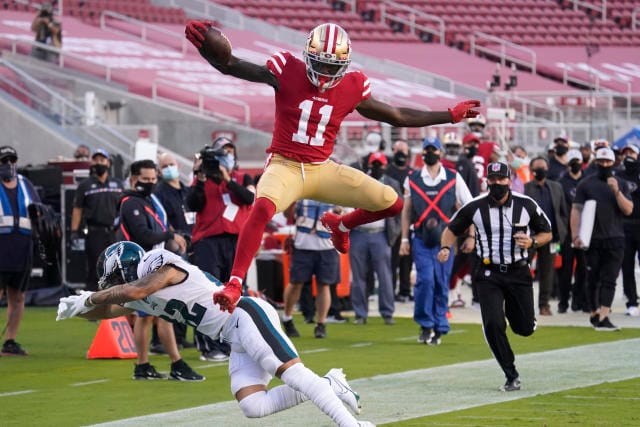
Week 11 Walkthrough: Brandon Aiyuk Hits Open Water
Welcome to the Week 11 Walkthrough.
In this article, I'll outline critical fantasy football context for this 11th glorious week of football.
(The stats below are from PFF, NFLfastR, rbsdm.com, RotoViz, FantasyLabs, ESPN, NFL Next Gen, and Fantasy Life).
Quick Links
- Cardinals at Texans, 1 PM
- Bears at Lions, 1 PM
- Steelers at Browns, 1 PM
- Chargers at Packers, 1 PM
- Raiders at Dolphins, 1 PM
- Giants at Commanders, 1 PM
- Cowboys at Panthers, 1 PM
- Titans at Jaguars, 1 PM
- Buccaneers at 49ers, 4:05 PM
- Jets at Bills, 4:25 PM
- Seahawks at Rams, 4:25 PM
- Vikings at Broncos, 8:20 PM
- Eagles at Chiefs, 8:15 PM, Monday
Cardinals at Texans, 1 PM
Cardinals Implied Team Total: 21.75
Kyler Murray’s return to action was largely encouraging. Sure, he played inefficiently. His one game slots him in as QB38 in EPA per game. But Murray was far better in success rate, ranking QB20. And Murray looked healthy, rushing six times for 33 yards and a TD.

Hopefully, Murray can build on a somewhat promising start in his second game back. And he gets a decent opportunity to do so against a Texans defense that ranks just 25th in EPA allowed per dropback. The Texans have a strong pass rush, but they aren’t very strong against the pass overall.

Helpfully, the Texans don’t take away first reads very well. That should help keep targets concentrated to Marquise Brown and Trey McBride, who both have high-end first-read target rates.
Honestly, I have those names listed in the wrong order. McBride is making a strong case that he is the top pass catcher in Arizona. He saw eight first-read targets to Brown’s three last week. And his 22% first-read target rate not only leads the Cardinals… it leads all tight ends. He’s a clear-cut TE1.
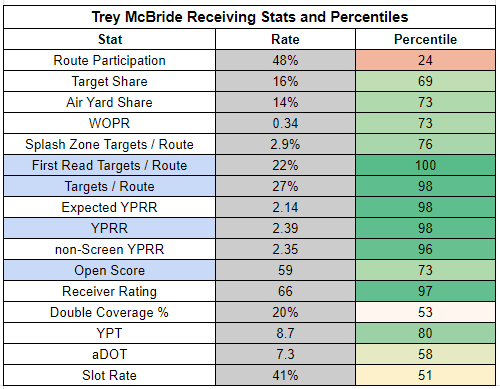
Marquise Brown is also a playcalling priority, with a 21% first-read target rate. And Brown’s 12.0 aDOT gives him big play upside on his targets. Given the Texans’ pass rush, McBride looks like the slightly better fit for the matchup. But Brown is a very solid FLEX.
Michael Wilson is also in play as a bet that the Cardinals play aggressively. If so, the Texans are likely to respond in kind, giving this matchup shootout potential.

But the Cardinals have been a conservative team, with a -4% PROE and a -3% PROE on 1st-and-10.

Last week they broke from that approach slightly. For the first time all season, they didn’t post a negative PROE. However… they’ve yet to hit positive territory.

The Cardinals could be tempted to play things conservatively here. The Texans have been decently successful against the run but they rank just 31st in PFF’s run grades and 23rd in run stop win rate. The Cardinals could look to test them.

Jonathan Gannon will likely have a lot more confidence in his running game now that James Conner is back in the lineup. Conner returned to a 63% snap share against the Falcons, with 67% of carries. He picked up where he left off.

Conner has been impressive on the ground this season, ranking RB10 in RYOE per game and RB19 in success rate. He’s set up for a strong workload and has been delivering efficiently, making him a high-end RB2.

Texans Implied Team Total: 26.75
C.J. Stroud was excellent against the Buccaneers two weeks ago and very good against the Bengals last week. He now has five games with a 60th+ percentile EPA per play, and four games with a 60th+ percentile success rate.

And when looking at the season-long numbers, Stroud is starting to look really impressive. He ranks QB7 in EPA per game, just ahead of Tua Tagovailoa. And he ranks QB16 in success rate, just ahead of Joe Burrow.

As impressive as Stroud has been, the Texans are still playing like they have a rookie QB. They have a -3% PROE and a -7% PROE on 1st-and-10 and their run-heavy approach has largely run counter to game script.

The Texans let Stroud sling it against the Buccaneers, but they went back to a conservative approach against the Bengals, posting a sub-optimal -12% PROE on 1st-and-10. I get that the Texans want to force defenses to respect the run, but man… -12% is the type of rate you see from teams desperate to hide their QB. As productive as Stroud has been, he could be even better if the Texans were willing to lean on him more.

But just because the Texans were overly conservative last week doesn’t mean that’ll be the case again this week. And if the Texans run the offense through Stroud this week, he could light up an extremely vulnerable Cardinals defense.
The Cardinals are weak against the pass, ranking just 29th in EPA allowed per dropback and 29th in success rate. Even better, they look especially ill-suited to stopping this Texans offense.
Stroud is having an incredibly impressive rookie season, so this isn’t to take anything away from him… but to some extent, he’s playing point guard. His passes are often beautiful and perfectly timed, but he’s also largely executing within a well-designed offensive system. This is illustrated by the Texans' high first-read EPA per dropback. Only the Lions and Dolphins rank higher.
For Stroud to be efficient, it’s helpful if the defense he's facing struggles to take away opponents' first reads. For example, the Bengals rank 24th in EPA allowed to first reads per dropback and the Buccaneers rank 25th.
The Cardinals rank dead last.
We also know that the Texans like to attack the deep middle of the field. They rank first in EPA on splash zone throws per overall dropback. The Cardinals rank 20th in defending the splash zone. It’s hard to know if the Texans will play aggressively this week. In some ways that’s up to Kyler Murray more than C.J. Stroud. But this sets up as an efficient outing for the impressive rookie.

However, this will be an especially tricky week to predict where Stroud’s throws will go, with Nico Collins expected to play. After Noah Brown’s ridiculous two-week stretch, Collins’ 2.63 YPRR no longer leads the team… but it’s still close. And Collins’ efficiency is backed up by a strong 22% TPRR, whereas Brown is seeing a much weaker 18% TPRR. Provided the reports on Collins’ health are positive heading into the game, he looks like a more trustworthy option than Brown—who has been absolutely crushing on his targets in a way that is simply unsustainable.

But Tank Dell looks like the strongest play at WR. Given that he’s a rookie, Dell’s routes seem the least certain. But Dell has led the Texans in routes for three straight weeks, with route participation of 93%, 87%, and 98%. It seems unlikely that he would lose significant playing time to accommodate Robert Woods.
Woods hasn’t been bad this season, but he’s hardly been a playmaker. He’ll likely be limited to a part-time role, primarily as a slot receiver.

Dell will likely work in the slot some as well, but Noah Brown should see work there more often. Brown has played 53% of his snaps in the slot, while Dell is at just 29%. The Texans’ most common 3WR set is likely to be Collins and Dell on the outside with Brown in the slot. Dell has an elite 2.12 YPRR, he ranks WR6 in open score, and he gets a great matchup. He’s a high-end WR2.
Dalton Schultz also remains a very strong play. Schultz is earning targets at a near-elite rate and has high-end route-running talent to back that up. He’s a locked-in TE1.

Arguably, the biggest issue for Texans receivers is the Cardinals' run defense. Arizona defends the run very poorly, ranking 24th in EPA allowed per play and 28th in rushing success rate. In combination with an offense that hasn't been pushing opponents, Arizona's poor run defense has turned them into a run funnel.

The hope here for the Texans' passing game is that Kyler Murray can change this dynamic. If not, Devin Singletary is going to get a lot of work.
A couple of weeks ago, on DVS MVP, I compared Singletary to creeping ivy. If you want a young RB to grow, make sure Devin Singletary isn’t around. Because whatever backfield he’s in… Singletary is gonna take it over.
That joke had more truth to it than I realized. Singletary is coming off a 23-point PPR outing against the Bengals, in which he played on 81% of snaps and handled 91% of carries.

With Dameon Pierce missing practice again this week, it should be Singletary’s show once again. Even in a great matchup, he doesn’t project for an efficient game, but he’s still a solid volume-based RB2.

Bears at Lions, 1 PM
Bears Implied Team Total: 19.25
Justin Fields is set to return from his Week 6 UCL sprain.
From an EPA per game perspective, Fields doesn’t profile as a huge improvement over Tyson Bagent. And from a success rate perspective, Fields profiles as a significant downgrade.

But although Tyson Bagent has performed impressively for the situation he was placed in, it’s very clear that he’s held the Bears’ offense back. Bagent has kept things from cratering but he hasn’t provided a ceiling either. He’s hit the 50th+ percentile in EPA per play just once this season, and that was back in Week 7.

Meanwhile, Fields has been much more boom/bust. He was dreadful in his first three outings before going off against the Broncos and Commanders.

This matchup sets up fairly well for Fields. The Lions have a good chance to be run first here, but they will do so with the goal of scoring points, rather than as a clock-burning tactic. As 9-point underdogs, the Bears are likely to need to air it out. This should keep passing volume reasonably high, which is not a given with the Bears. Even in Fields’ breakout games, they were balanced.

Things don’t always go well when teams are forced to pass. Predictable offense is easier to defend. But fortunately, the Lions are easier to attack through the air than on the ground. And the Lions look like a solid matchup for Fields in particular. They are allowing explosive pass plays at the fifth-highest rate.

The Lions’ strong run defense, unimpressive pass defense, and a consistent ability to score points on offense have turned them into a pass funnel. Teams are averaging a 69% pass rate against them, with a 4% PROE and a 4% shift to the pass. If Fields is healthy, we could see volume and efficiency in the Bears passing game.
DJ Moore remains the clear focal point of the downfield passing game. Darnell Mooney has flashed in the box score a bit in recent weeks, but Moore has a strong lead across the board. Even after 4+ games with Bagent, he has an elite 2.26 YPRR. With Fields under center and the potential for strong passing volume, Moore profiles as a high-ceiling WR2.
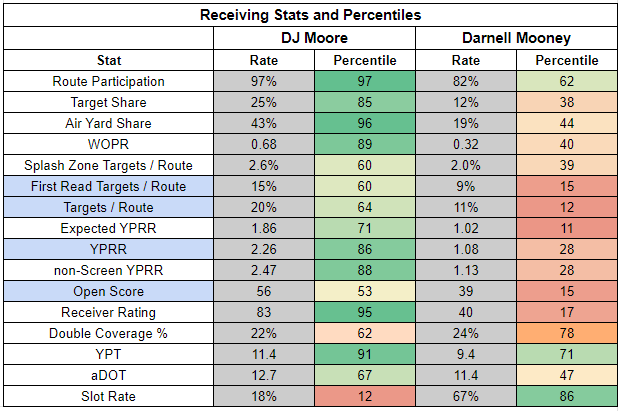
Cole Kmet also gets a huge boost from Fields’ return. Kmet has a strong 21% TPRR and can rack up catches if the Bears are willing to drop back frequently. He’s a TE1.
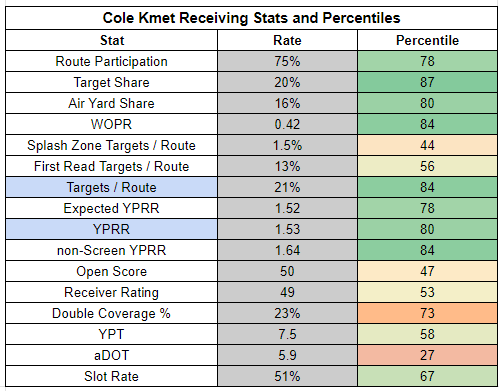
The backfield is more difficult to parse. Khalil Herbert didn’t return for Thursday Night Football in Week 10, but he logged three full practices before the game. We should see him return from his high-ankle sprain this week.
D’Onta Foreman demonstrated elite consistency in Herbert’s absence. His 45% success rate ranks RB10.

But Herbert was excellent across the board as a rusher before being injured. His 55% success rate trails only De’Von Achane (60%) and he’s been far more explosive than Foreman.
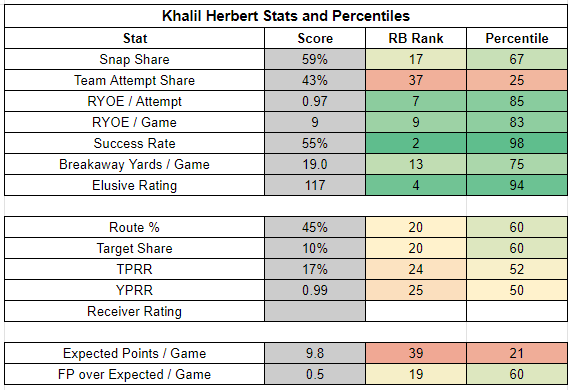
Even before the injury, Herbert didn’t have a total lock on carries though, so he’s unlikely to see a huge chunk this week. But he looks like the Bears’ best RB, and they likely know it.
Still, Herbert is mostly a bet on a TD in his first game back.
Roschon Johnson is likely to have a role as well. Johnson handled 51% of routes against the Panthers, and will likely limit Herbert to more of a two down role.

Lions Implied Team Total: 28.25
Generally, the Lions are a run-first team that is responsive to game script. If allowed to play from out front, they will usually establish the run. If pushed to the air, they will generally shift their approach to meet the game environment. We saw this quite clearly in their loss to the Ravens.

Week 6 was the one exception to their baseline tilt to the run. But David Montgomery was injured in that game and they were without Jahmyr Gibbs.
With both Montgomery and Gibbs back in the lineup and delivering high-end rushing production, it’s hard to imagine them shifting to an aggressive game plan here. As 9-point home favorites, they are likely to dictate the run.

Unfortunately, the Bears are stout against the run, ranking second in EPA allowed per rush, first in rushing success rate, and fourth in run stop win rate. But this is a strength-on-strength matchup and one that I don’t expect Dan Campbell to back down from.

The Lions' run game is genuinely impressive. Jahmyr Gibbs has been an efficient receiver but is also adding an explosive rushing element. Inconsistency is his only issue.

David Montgomery has been an ideal complement, adding elite consistency to the backfield, while still providing burst.

In Montgomery’s first game back, Gibbs led the way with a 58% snap share, a 45% carry share, and a 16% target share.

Montgomery operated as the clear No. 2. Even still, he’s in the RB2 mix here as a bet on the Lions fully controlling this game.

It’s tough to know if this split will continue, but it’s certainly an encouraging sign for Gibbs, who profiles as a low-end RB1 here. The nice thing for Gibbs is if the Bears push back more than expected, he only stands to benefit. He ranks RB6 in targets per route run, so the more passing the better.
And the Lions could be tempted to play more aggressively than usual. The Bears have been a minor pass funnel.

Bears opponents are faced with a strong run-defense unit and a legitimately vulnerable pass defense. Chicago isn’t getting to the passer and is unimpressive in coverage. The Bears have effectively limited big plays, but they look like the type of defense that Jared Goff should have no trouble picking apart.

Goff has been very effective this season, ranking QB12 in EPA per game and QB9 in success rate. He’s not an elite QB, but he’s quite capable of consistently hitting short throws against a weak pass defense.

Although overall passing volume is a question mark here, targets will be concentrated. Jameson Williams is coming off a season-high 55% route participation. It’s encouraging to see his playing time increase, but he’s also a long way off from being a full-time player. And regardless of who is on the field, Amon-Ra St. Brown has by far the strongest connection with Jared Goff. He should be peppered with targets, as usual.
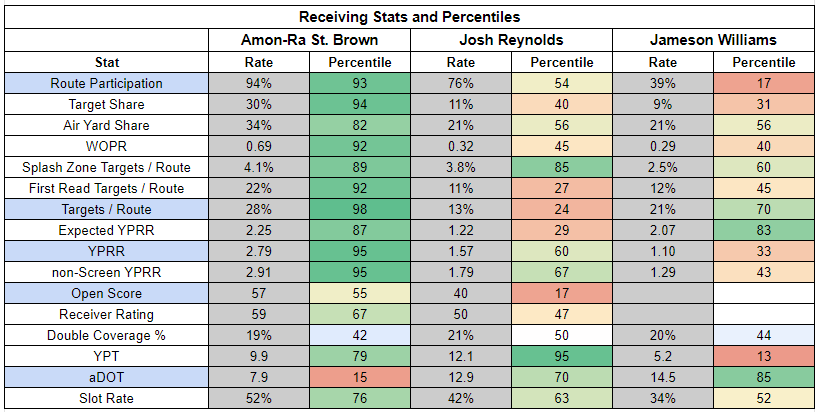
Sam LaPorta also looks set up for a strong outing. With a 21% target share, LaPorta is the clear No. 2 in the passing game. And with a 1.75 YPRR, he’s been impressively efficient. He’s a locked-in TE1.

Steelers at Browns, 1 PM
Steelers Implied Team Total: 17.25
Kenny Pickett hasn’t been disastrous in his second season. He’s not Zach Wilson. But he’s been bad. Pickett is averaging -3.4 EPA per game. He’s worth more than a field goal to the opposition.

Pickett now faces the most difficult pass defense in the NFL. The Browns have harassed opposing passers, without blitzing at a high rate, and are solid in coverage.

Because the Browns are so difficult to pass on, teams are just… not doing that. Teams are averaging a -4% PROE against Cleveland and are shifting 4% to run, making them one of the NFL’s biggest run funnels.

The Steelers don’t need much convincing to run the ball. They’ve been a run-first team this season and have gone run first from a variety of game scripts. Pittsburgh isn’t a total lock to play conservatively; they’d likely air it out if the Browns push them. But with Deshaun Watson now on IR, that is much less likely.

The issue with running on the Browns is that they aren’t easy to run on, it’s just the path of least resistance.

Fortunately, the Steelers have one of the league’s best 1-2 punches at RB… now that they're starting to realize where their power comes from.
Ahead of Week 10, Mike Tomlin named Jaylen Warren the team’s starting RB.
Warren totaled 110 yards from scrimmage and a TD while handling 52% of snaps.

The important context here is that Tomlin announced Warren as a starter for a home game, and afterwards, talked up the importance of acknowledging his players in that way. This doesn’t look like a true changing of the guard. Instead Tomlin appears to be publicly recognizing Warren’s talent and ability.
before everyone goes too overboard on the “Mike Tomlin named Jaylen Warren the starting RB” headlines, I think this entire clip is worth a watch for full context
— The Coachspeak Index (@CoachspeakIndex) November 15, 2023
(this is still good for Warren) pic.twitter.com/JIuBC5CyhJ
To some extent, who Tomlin considers the “starter” is immaterial. Even last week, Najee Harris handled 47% of carries to Warren’s 44%. Snaps could move further toward Warren or back toward Harris, but a split of some kind is very likely.
Still, Warren’s touch floor now looks considerably higher than it did early in the season. And Warren has been very impressive as both a rusher and receiver. Given a more reliable workload, he profiles as an RB2.

Harris hasn’t played terribly this season, but he hasn’t played impressively either. With his workload now likely capped, he’s an efficiency play. And the efficiency just isn’t there. As a result, he’s a TD-or-bust bet.
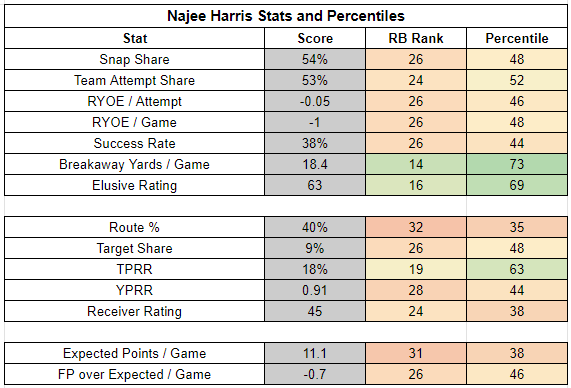
In this extremely difficult passing matchup, it’s difficult to get excited about Diontae Johnson or George Pickens.
The silver lining for Johnson is that the Steelers have been force-feeding him targets since he returned from injury. His 23% first-read target rate is an elite mark and sets him up for a more reliable target rate than Pickens.

The silver lining for Pickens is that he’s faced double coverage at a much higher rate than Johnson and the Browns double WRs at the lowest rate in the league. Less defensive attention should help, although he’ll need to hope the Steelers can protect well enough for his deep route tree to develop.
Browns Implied Team Total: 16.25
Deshaun Watson was very mediocre this season, turning in similar efficiency to Gardner Minshew, Sam Howell, and Derek Carr. But with Watson now on season-ending IR, the Browns still face a major downgrade at QB. They reportedly plan to start Dorian Thompson-Robinson, who has been significantly less efficient than P.J. Walker—and both QBs have been bad.

Even when starting Watson, the Browns weren’t inclined to feature the passing game. They’ve had a positive PROE just once all season and were very conservative with Watson over the last two weeks. They’re almost certain to be run heavy this week, but that won’t represent a major shift from their recent play calling.

This matchup won’t get in the way of a run heavy game plan. The Steelers are very likely to play things conservatively on offense, so the Browns would need an extremely compelling matchup-driven reason to shift to the pass. They don’t have that here.
The Steelers are mediocre against the run, and opposing teams have had no issue being run first against them.

The Browns are leaning on the run game, and increasingly, that means leaning on Jerome Ford. Ford saw a 66% snap share and a 59% carry share against the Ravens. Both were career highs.

Ford has been a boom/bust runner this season, but he was highly consistent last week with a 53% success rate. Ford’s explosiveness has been impressive. If he can pair that with better consistency, the Browns should feel more comfortable leaning on him with a true lead back workload. He’d be a locked-in RB2 with Watson. As is, he’s more of a bet on a TD.

When the Browns drop back, the biggest issue will be Pittsburgh's pass rush. The Steelers rank ninth in quick pressure rate and blitz frequently and effectively. We’ll see some sacks.

The Steelers have been vulnerable to big plays, but we’re unlikely to see Amari Cooper or Elijah Moore running free downfield. The Steelers are double-teaming WRs at the third-highest rate. And in their Week 2 matchup, Cooper was double-teamed on 31% of his routes, with Moore seeing a 32% rate.
Cooper normally faces a lot of defensive attention, but it's less common for Moore to be double teamed. The Browns' QB play and overall passing volume are bigger issues for the WRs, but this doesn’t look like a great matchup for Cooper or Moore.

With the Steelers likely to be getting after Thompson-Robinson, we could see some designed targets for David Njoku. The tight end has an absurdly low 3.0 aDOT and has been heavily utilized in the screen game. His 1.36 YPRR drops to just 1.05 on non-screen routes. Still, I imagine you have a better option than betting on some screens to materialize.
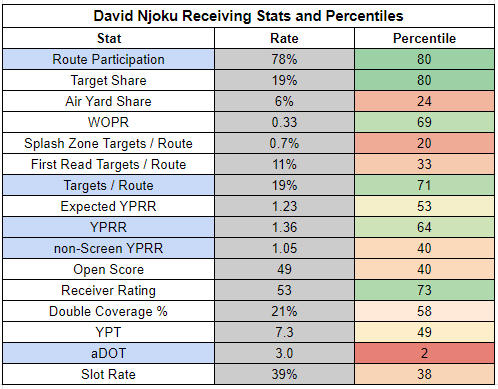
Chargers at Packers, 1 PM
Chargers Implied Team Total: 23.5
Justin Herbert had his most efficient game of the season against the Lions, with a 91st percentile mark in EPA per play. It was his third elite showing of the season.

But even with Herbert playing extremely well, the Chargers weren’t aggressive against the Lions. They posted a 1% PROE with a -6% PROE on 1st-and-10. They haven’t been truly pass heavy since Week 6.

The Chargers now get a Packers defense that ranks just 25th in EPA allowed per rush and 22nd in rushing success rate. The Packers have been a run funnel this season, and are not the type of offense to push the Chargers off of a balanced or run-first game plan.

At least carries will be concentrated to Austin Ekeler, who has handled 70%+ carry shares in back-to-back weeks.

But, clearly, Eekeler will be better off if the Chargers play aggressively here. He’s been whatever as a rusher, but extremely efficient as a receiver, with elite marks in YPRR and receiver rating.
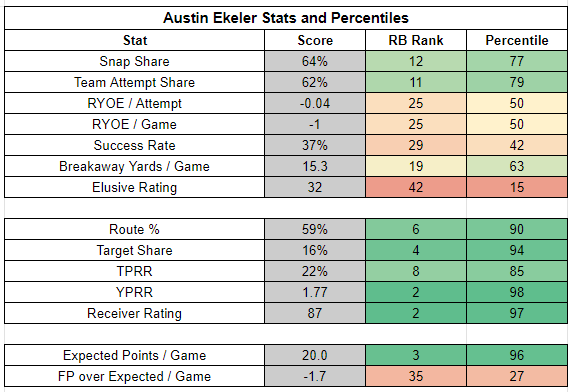
The Chargers could certainly justify a pass-heavy attack here. The Packers don’t get after the passer well, and protecting Herbert has been the Chargers' biggest passing-game issue. And while Green Bay is solid in coverage, they’re not likely to fare well if Herbert is dealing from a clean pocket.

After last week’s elite marks, Herbert is up to QB6 in EPA per game and QB10 in success rate. He’s profiling as a high-end passer again.

Last week, Keenan Allen faced a Lions defense that doesn’t double-team WRs at a high rate. He now gets a Packers defense that plays things similarly. That lack of defensive attention is extra nice since attention from Herbert is a certainty. Allen is getting open at an elite rate and Herbert is constantly looking his way.
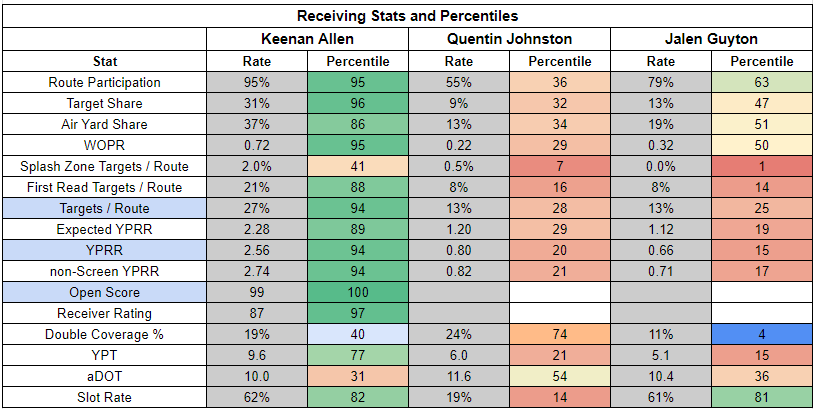
With Mike Williams and Josh Palmer out, Allen’s target competition is woeful. He should dominate targets once again here.
Packers Implied Team Total: 20.5
Jordan Love ranks QB16 in EPA per game and QB31 in success rate so his Week 10 loss to the Steelers should be all that surprising.

With an inconsistent QB under center, the Packers have been inclined to play things conservatively. They have a PROE of -3% or lower in 5-of-9 games, including three of their last four.

This matchup sets up as one where the Packers can attack on the ground. Sure, the Chargers’ offense might have something to say about that, but the Packers' run defense is weak enough to hold the Chargers focus. That could keep the score from getting completely out of hand, allowing the Packers to play conservatively throughout.
And they’ll be running against a middling Chargers run defense.

Aaron Jones will lead the rushing attack but he may not have a high-end workload. After jumping to a 57% snap share in Week 9, he held steady against the Steelers. This is a disappointing development for a team you would expect to be featuring Jones.

But in the Packers' defense, A.J. Dillon has – shockingly – been a better rusher than Jones this year. Dillon, of course, has not been good, just better than Jones.

Jones has been concerningly inefficient on the ground, ranking RB47 in RYOE per game and RB37 in success rate. Fortunately, he’s still flashing as a receiver.

Jones’ best case scenario is that the Chargers pushing the Packers into a pass-heavy approach, which would set him up for a big day as a receiver. And the Packers shouldn’t be afraid of this pass defense. Despite Los Angeles’ weak run defense, they have not been a run funnel.

This makes sense—the Chargers are even worse against the pass than the run.

For fantasy purposes, though, the Packers passing offense is tough to sort out. Jones offers a nice way to play it in the backfield, but the WR situation is much murkier.
Christian Watson and Romeo Doubs are the clear leaders in route participation. Over the last two weeks, Watson has been at 81% and 79% route participation, with Doubs at 81% in both outings. Jayden Reed has seen rates of just 45% and 56%. But although Watson and Doubs have a big lead over Reed in playing time, their playing time is still well short of elite. True No. 1 WRs typically see 90%+ route participation, or even 95%+. Watson and Doubs have good but not great playing time profiles.
And when looking at targets, things get even less clear. Doubs actually leads the trio in TPRR (20%), but just barely. Watson and Reed are both at 19%. And Reed has been the most efficient by far, delivering 1.88 YPRR, with Watson at 1.33 and Doubs at just 1.23.

Ultimately, I think this is a case where open score can help us sort things out. Reed is performing poorly in the metric. Combined with highly uncertain playing time, he’s no more than a dart throw. Doubs has been getting openly decently well and is running routes at a solid rate. He’s a viable bet on a TD.
Watson continues to be the most interesting of the three. His open score is impressive and he runs routes deep downfield, with a 17.3 aDOT. His target rate isn’t great, but he can turn a few targets into a big day.
Luke Musgrave continues to have a middling profile, with a 16% TPRR and a 1.32 YPRR. But he’s in play as a bet that the Packers play from behind this week.
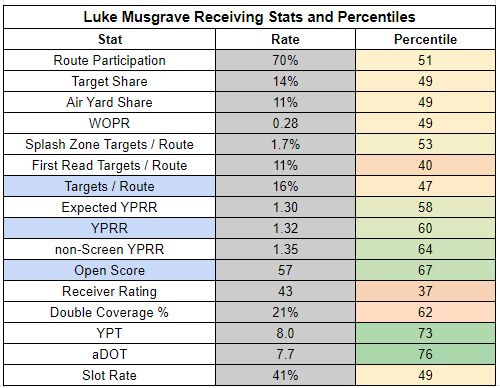
Raiders at Dolphins, 1 PM
Raiders Implied Team Total: 16.5
The Raiders are 2-0 under Antonio Pierce. But those wins have come in game environments where Pierce could justify very conservative playcalling. Against the Giants, the Raiders posted a -11% PROE, and they were at -14% last week.

The Raiders now get a Dolphins defense that has been very poor against the run, ranking just 29th in EPA allowed per rush and 27th in rushing success rate.

But the Dolphins rank far better in PFF’s run grades and ESPN’s run stop win rate. They’re likely to be able to contain Las Vegas more easily than the Raiders might think.
It’s also dangerous to go run-heavy against the Dolphins, given their propensity for putting up points. Despite their poor run-defense efficiency, the Dolphins are not a run funnel.

Josh Jacobs has run better over the last two weeks, posting a 50% success rate against the Giants and a 41% success rate against the Jets. But even in those games, Jacobs didn’t show much burst, combining for -11 RYOE. He looks to be improving on his season-long rushing profile, but his efficiency remains worrying.

Given his RB10 ranking in YPRR and RB4 ranking in ESPN’s receiver ratings, Jacobs is best off if the Dolphins push the Raiders here, making him an interesting correlation play with the Dolphins’ passing attack.
And if the Raiders take to the air, they’ll likely be looking to get the ball out quickly. The Dolphins have a strong pass rush and blitz frequently and effectively.

Aidan O’Connell hasn’t been terrible this season, but his efficiency is a little close to Mac Jones’ for comfort. He ranks QB36 in EPA per game and QB21 in success rate.

We do at least have more clarity on where the ball will be going than when Jimmy Garoppolo was under center. Over the last two games, Davante Adams has seen a 25% first-read target rate with target shares of 29% and 50%. The Raiders have been absolutely feeding him and he’s shown a strong connection with O’Connell. Jakobi Meyers was decently involved against the Giants, with a 19% target share. But he dropped to just 9% last week, with just one first-read target. Adams now has a big lead in first-read target rate, TPRR, and YPRR.

But to a large extent, Adams’ recent increase in usage is a choice. Meyers is still getting open with impressive ease. Adams has a much higher target floor. But if the Raiders have to abandon a controlled run-heavy attack, Meyers’ ability to get open should lead to volume in comeback mode.
Michael Mayer looks like a thin bet even if the Raiders are forced into a lot of passing volume. He’s logged 60% and 69% route participation over the last two weeks, which is lower than ideal. And he’s not yet flashing as a target earner.
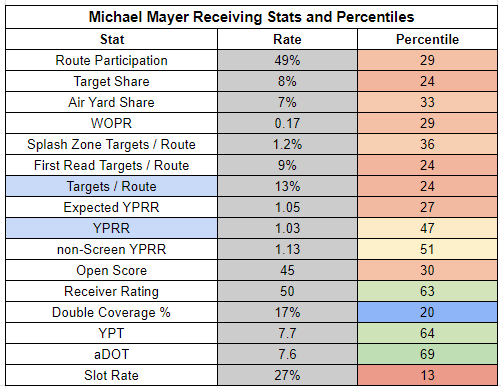
Dolphins Implied Team Total: 30
After starting off the season incredibly impressively, Tua Tagovailoa’s play has dropped off. He’s coming off an 18th percentile success rate against the Chiefs, his lowest of the season. And his three worst success rates were all in his three most recent games.

Still, Tua ranks QB8 in EPA per game and QB3 in success rate—which underlines just how impressive he was to start the season.

Miami now gets a solid Raiders pass defense. Specifically, they’ve been good at preventing big plays and limiting efficiency on splash zone throws. These strengths clash with the Miami passing game’s plan of attack.

Then again, there’s a difference between stopping other teams' over-the-middle passing attack and stopping Miami’s. And the Raiders do not look well suited to pressure Tagovailoa, which is a major problem. Tagovailoa ranks QB2 in EPA per dropback with a clean pocket.
The way to disrupt this attack is to generate pressure. The Raiders have a weak pass rush, and don’t blitz, so Tua should have time to throw.
The Raiders also don’t double-team very often. Only the Browns are double-teaming their opponents’ top option at a lower rate. And while the Raiders pass defense is pretty good… they aren’t the Browns.
If the Dolphins play things at least somewhat aggressively, Tyreek Hill should return to the massive ceiling he showed early in the season. The Raiders are unlikely to push the Dolphins, which makes a true mega-performance less likely. But Hill still provides a rare combination of efficiency and volume.

Jaylen Waddle also looks well positioned for a good game. Waddle continues to have impressive numbers, when not evaluated in comparison to Hill’s ridiculous efficiency. He’s a strong WR2.
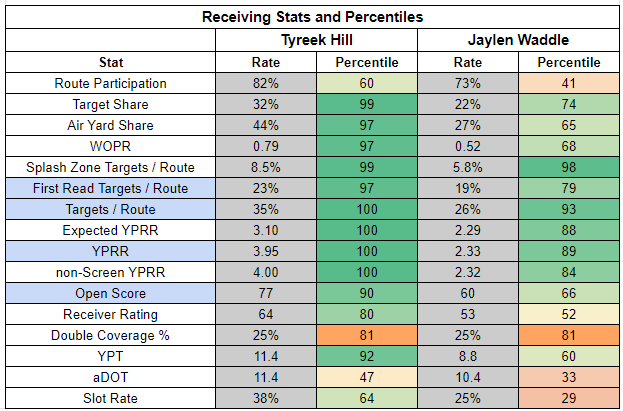
The main concern for Hill and Waddle is that the Dolphins won’t need to pass very often this week. If the Raiders are stubborn about their run-heavy approach or O’Connell is exposed by Vic Fangio’s defense, Miami’s passing volume could be frustratingly low. We’ve seen the Dolphins go very conservative in several outings this year.

A run-heavy approach should be successful against a Raiders’ inefficient run defense that is a minor run funnel.

With De’Von Achane back in the lineup, it’ll be hard to blame Mike McDaniel if he gets carried away with running the ball. Achane’s rushing profile has been as good as it gets… literally.

Before suffering a knee injury in Week 5, Achane looked to be moving into a 1A role in the Dolphins backfield. In Weeks 3-5, he handled 42%, 47%, and 50% of carries.

Raheem Mostert has handled a majority of carries in the four games since.

Mostert has also been a very impressive rusher this season, and Achane won’t simply displace him. Instead, they’ll form a split of some kind. Both RBs are bringing elite efficiency to the table and both are strong plays even with the workload divided. Achane profiles as an RB1 – I'm not benching the RB1 in every rushing metric – while Mostert profiles as a solid RB2.

Giants at Commanders, 1 PM
Giants Implied Team Total: 13.75
Tommy DeVito has been an extremely rough watch, ranking QB45 in EPA per play and QB44 in success rate. Mom’s chicken cutlets aren’t hitting like they used to.

Brian Daboll doesn’t even have the decency to hide Devito. The maniac is still playing like he can win.

Even with DeVito at QB – maybe not but let's go with it – the Giants could have success through the air here. The Commanders rank 30th in EPA allowed per dropback and aren’t generating a pass rush.

The Commanders aren’t great against the run, though. And that’s helped keep them from turning into a major pass funnel. We’re seeing a slight lean to the pass against Washington, but nothing major. Still, any passing efficiency on moderate volume would be a welcome relief here.
But I can’t imagine actually playing a Giants WR in fantasy. Darius Slayton is the only WR to log 65%+ route participation over the last two weeks but has a 1.00 YPRR. No thanks. Wan’Dale Robinson is only slightly better at 1.11 YPRR and has posted route participation of 52% and 59% over the last two weeks. Please, tell me you have a better option… you have to have a better option.
Saquon Barkley is the only fantasy-relevant player in the offense. He continues to carry the load for the Giants with 72%+ carry shares in every game since returning from injury.

And Barkley has played well this season, ranking RB12 in rush yards over expected. One reason I like RYOE is that it uses the player tracking data to account for play context like defender positioning… but the metric doesn’t know how bad the Giants’ QB situation is. Barkley is in a tremendously difficult position and is still producing. He’s a low-end RB1.
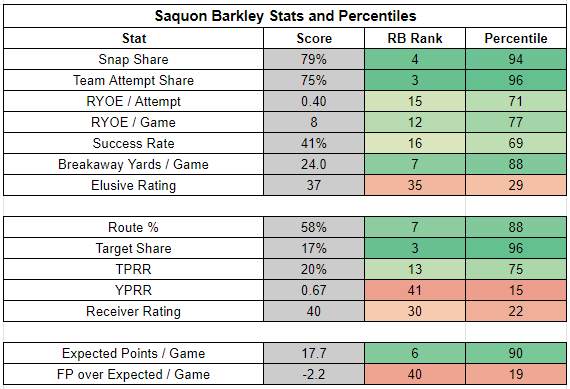
Commanders Implied Team Total: 23.25
Sam Howell has been very solid over the last three weeks, finishing in the 54th-64th percentile in EPA per play.

He’s now up to QB19 in EPA per game.

However, Howell is just QB28 in success rate. He remains inconsistent. And Howell’s most recent bad game is against this very Giants defense. The Giants have been lit up by the Raiders and the Cowboys over the last two weeks, but they proved very difficult for Howell in their first meeting.
The Giants don’t cover very well but they get to the passer and they have no issue with bringing extra defenders to aid in that effort.
Howell will have to prove that he’s better at handling the blitz than he was a month ago.

But there’s no doubt that the Commanders will let Howell show what he can do. Only the Bengals (10%) and Chiefs (9%) rank higher in PROE than the Commanders (9%).

And the Commanders are consistently pass heavy, with a PROE of at least 6% in 8-of-10 games. They have also been pass heavy from a variety of game scripts.

Howell is always a good bet to take sacks, and this matchup will likely amplify that tendency. But we should also get passing volume. And with most teams facing Tommy Devito that wouldn’t be the case.
That makes Terry McLaurin somewhat interesting. McLaurin has a big lead on Jahan Dotson in first-read targets and TPRR. He built on that lead last week with eight targets to Dotson’s two and six first-read targets to Dotson’s one. Curtis Samuel returned to the lineup in Week 10 but ran a route on just 53% of dropbacks. McLaurin’s profile is pretty uninspiring, but it’s also the best Washington has to offer at WR.
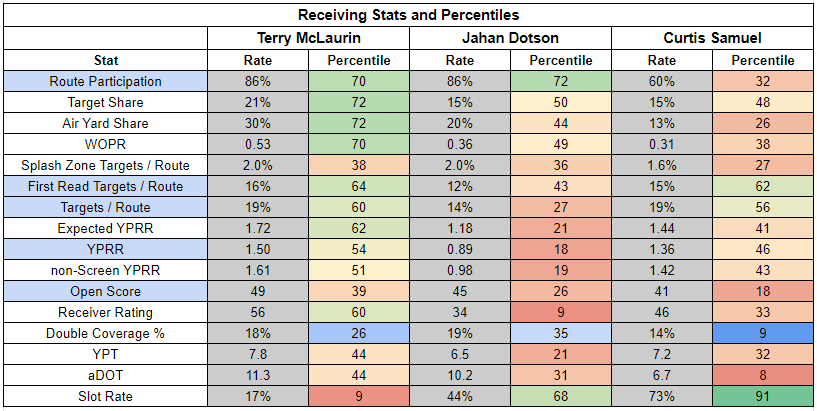
At tight end, Logan Thomas continues to run a lot of routes, logging 85% route participation against the Seahawks. Thomas’ 16% TPRR and 1.11 YPRR make him a bet on overall passing volume. The Commanders are likely to pass frequently here by normal standards, but by their standards, passing volume should be on the lower side this week.

With the 9-point home-favorite Commanders expected to control this game, Brian Robinson is well-positioned to build on his best fantasy outing of the season last week. Ironically, Robinson saw just 57% of the carries last week with a 51% snap share. If that’s all you knew, you wouldn’t be very excited about his fantasy output. But Robinson posted a season-high 15% target share and 32% TPRR, showing an impressive jump in his receiving game usage.

Robinson has been an efficient receiver all season and now ranks RB4 with a 1.70 YPRR. This game sets him up for a strong rushing workload. If he adds receiving usage on top of that, he’ll have no trouble delivering low-end RB1 value.

Cowboys at Panthers, 1 PM
Cowboys Implied Team Total: 26.5
Since their Week 7 bye, the Cowboys have fully committed to the pass. They’ve posted PROEs of 16%, 9%, and 10% with even more aggressive rates on 1st-and-10.

And Dak Prescott has excelled under this new playcalling strategy, delivering three elite outings in a row.

But if there was ever a rushing matchup designed to get the Cowboys to return to a more balanced approach… this is it. The Panthers rank dead last in both EPA per play and success rate, 31st in run stop win rate, and 30th in PFF’s run defense grades. Carolina cannot stop the run.

But even as the league’s worst run defense, Carolina hasn’t emerged as a gigantic run funnel. Sure, teams are going run heavy against them and shifting to the run, but it’s not as dramatic as you might expect.

The simple reason for this is that the Panthers aren’t great at stopping the pass either.
And delightfully, they blitz frequently and routinely give up big plays when doing so. This is a perfect weakness for Dak Prescott to exploit. He has been excellent against the blitz this season.
The bigger issue for the Cowboys has been protecting Prescott from a typical four-man rush, but the Panthers aren’t very good at getting to the passer with the traditional rush.

And if the Cowboys opt to lean into the passing game again this week… good for Mike McCarthy. He’d simply be putting the ball in the hands of a QB playing elite football. Prescott is up to QB3 in EPA per game and QB4 in success rate.

The Panthers have been decently successful at limiting the opposition’s success on first-read throws, but it’s hard to believe they can take away CeeDee Lamb, who is absolutely cooking. Lamb’s ultra-elite 3.04 YPRR is backed up by an elite 27% TPRR. That, in turn, is backed up by a 95th percentile open score. Only Keenan Allen, Brandon Aiyuk, and Garrett Wilson rate higher in ESPN's open score.
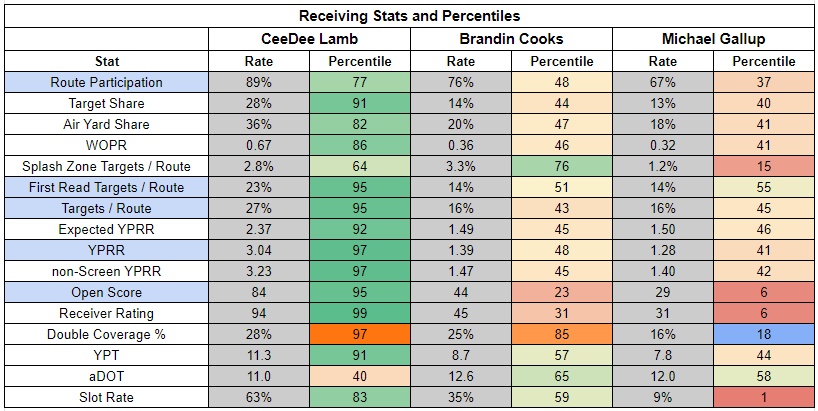
And although Brandin Cooks is coming off a big game, it’s worth noting how much better Lamb has been in open score. Cooks and Michael Gallup are capable of big days because of how well Prescott is playing. But Lamb is taking this offense to another level.
Jake Ferguson was pretty quiet against the Giants, but he remains a strong play. Ferguson’s 19% TPRR is very strong for the position, as is his 63 open score. Even if passing volume is limited, Ferguson has a good chance of finding the end zone.
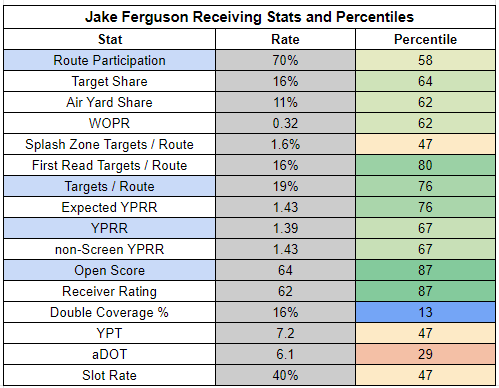
Unfortunately, Tony Pollard continues to bring very little to the table. He keeps getting one favorable matchup after another and doing nothing with them. But this is like… the favorable rushing matchup. I know it’s not fun, but Pollard should be in lineups.
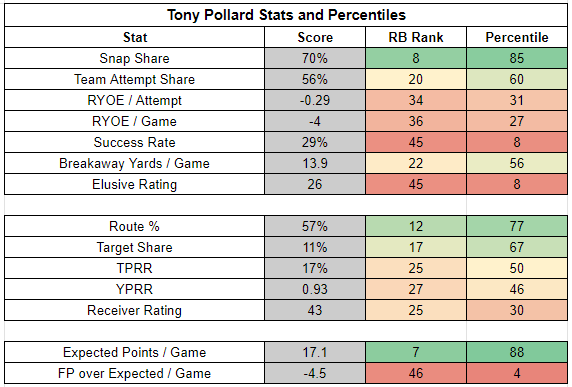
Panthers Implied Team Total: 16
Rookie-year struggles are forgivable, but you at least like to see flashes. Bryce Young arguably flashed a bit against the Lions in Week 5, but that was garbage time production. His only decent outing came in a 15-13 win over the Texans, and even then he finished just 54th percentile in EPA per play.

For the season, Young ranks just QB41 in EPA per game and QB39 in success rate. He’s dangerously close to Zach Wilson.

Young now gets a Cowboys pass defense that has been exceptional at getting to the passer, ranking first in pass rush win rate and first in quick pressure rate. The Cowboys have let up some big plays, especially over the middle of the field. But the Panthers have been absolutely terrible at generating big plays this season. This looks like a very poor setup for Young.

The Cowboys have also been effective at limiting first-read production. At first glance, this seems like a problem for fantasy managers, since Adam Thielen is the only fantasy-relevant receiver in this offense. But Thielen hasn’t been living off of first reads this year. His production has been driven by an ability to get open and a strong connection with Young.
In addition, the Cowboys don’t double-team at a high rate, which should help Thielen as the clear top option in the offense. In fact, given his shallow 7.1 aDOT, Thielen actually profiles as a strong fit for this matchup.
I expect Young to struggle badly this week, but what production we do get should flow through Thielen.
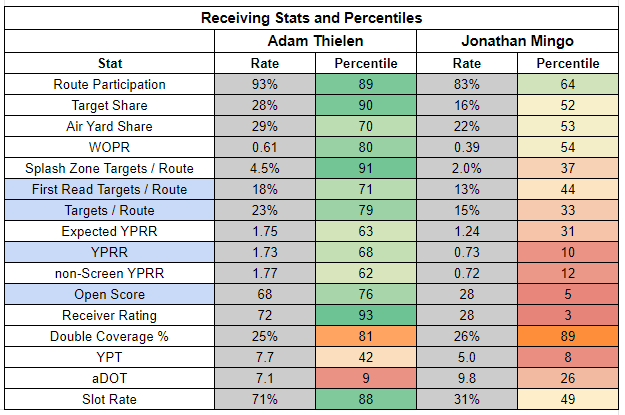
Despite being solid against the run, the Cowboys have become a minor run funnel. Teams are hoping to avoid Dallas’ elite pass rush.

In 2-of-3 games as the Panthers' playcaller Thomas Brown was pass first. But… Frank Reich announced he’s retaking playcalling duties this week. We’re likely to see the Panthers try to hide Young a bit more.

I’m not sure if it was Brown’s idea to use Miles Sanders as a passing down back, but if so, I get the change. Sanders has handled just 26% and 15% of carries over the last two weeks but he saw a 14% target share against the Colts and logged 43% route participation against the Bears.

Meanwhile, Chuba Hubbard continues to dominate rushing work, while losing some receiving work to Sanders.

The split is weird, given that Sanders ranks just RB33 in receiver rating and is very inefficient in YPRR, as he was last year. But perhaps the Panthers are just trying to find some way that Sanders can contribute because he’s been even worse as a rusher.
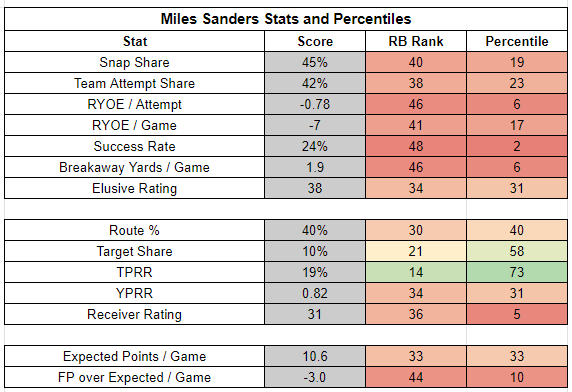
Hubbard’s 0.67 YPRR is even worse than Sanders’, which helps explain Sanders’ recent uptick in receiving usage. However, Hubbard ranks RB11 in receiver rating, so he’s probably run bad as a receiver to some extent. The Panthers' willingness to lean on Hubbard as a rusher is also good news for this matchup specifically since they will be looking for a way to move the ball without asking Young to drop back. And Hubbard has earned that trust with an elite 46% success rate. This is a brutal matchup for the offense overall, but Hubbard is still a volume-based RB2 fill-in.
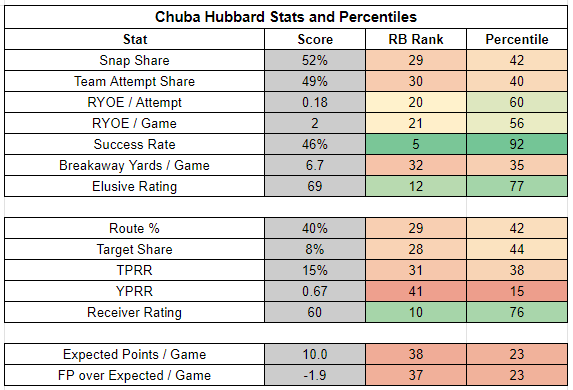
Titans at Jaguars, 1 PM
Titans Implied Team Total: 16.5
Will Levis had a very fun debut against the Falcons, hitting DeAndre Hopkins with moonball TDs. But then defenses had an epiphany… what if we make him do literally anything else? That hasn’t gone great for Levis.

Levis’ success rate has been a major red flag since his very first NFL game. But his EPA is now beginning to reflect his very poor consistency. Levis ranks QB32 in EPA per play and QB41 in success rate.

Levis still has big-play upside, but the frequency with which he’s going to produce those plays was dramatically overstated by his first appearance. And Levis now gets a very difficult matchup.
The Jaguars rank seventh in EPA allowed per dropback and fourth in coverage grade. They don’t have a great pass rush, but they still look likely to make life difficult for Levis.

Weirdly, the Jaguars have been a pass funnel this season. But the Titans are unlikely to shift their approach much here. With a struggling rookie under center, they’ll prefer to attack on the ground.

The Jaguars have looked like a paper tiger run defense for weeks. And after facing the 49ers, that's finally showing up a bit in EPA per rush. Last week, the 49ers were very efficient on the ground, ranking sixth in rushing EPA in Week 10. But the Jaguars got the last laugh by breaking Christian McCaffrey’s TD streak. Still, this is a defense that can be run on. And the Titans are going to try.

Derrick Henry will dominate snaps, operating as the focal point of the Titans' rushing attack… unless Tennessee shifts into comeback mode. Henry’s snap share has fluctuated this year, but his carry share has not.

Henry has an impressive rushing profile. He’s not as dominant as he was in his prime, but he can still make good use of a big workload. With Tyjae Spears in the backfield, Henry’s more game-script-dependent than he used to be, but Henry is still a solid RB2.

The Titans won’t be looking to pass the ball much this week, but that ultimately may not matter. If the Jaguars offense can put up enough points, the Titans will be forced to air it out a bit. And for our purposes, it’s helpful that targets are highly concentrated to DeAndre Hopkins. Even while posting a disappointing 3/27/0 receiving line against the Buccaneers, Hopkins saw nine targets for a 25% target share. He’s the engine of the passing offense.
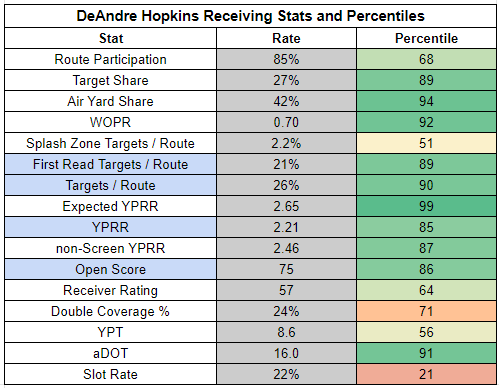
And although Hopkins doesn’t generate much separation he still rates very well in open score, which includes additional factors like defender positioning, and the WR’s speed, relative to the defender. Hopkins’ open score is in line with Tyler Lockett's. Lockett generates much more separation than Hopkins, but there are different ways to earn targets in the NFL. Hopkins’ open score indicates he isn’t just a big name being fed targets, he’s still worthy of operating as a true No. 1.
Jaguars Implied Team Total: 23.5
Trevor Lawrence is coming off his worst game of the season. He posted a ninth-percentile EPA per play and a 19th-percentile success rate against the 49ers.

Lawrence now looks pretty shaky in terms of season-long EPA, ranking just QB21 in EPA per game. He looks better from a success rate perspective, though, ranking QB11. That discrepancy sets Lawrence up as a positive regression candidate.

Lawrence now gets a Titans defense that isn’t the pass funnel they used to be. In fact, the Titans are profiling as a bit of a run funnel. Teams are averaging just a 60% pass rate against them with a -1% PROE.

But just because teams can run on the Titans doesn’t mean that the Jaguars will want to. And with a 4% PROE, the Jaguars have a clear lean to the pass.

To sum up… previously, teams felt obligated to attack the Titans through the air. Now they can attack however they want. And the Jaguars are likely to prefer an aerial assault. That could go quite well against a defense that ranks just 28th in EPA allowed per dropback and 29th in success rate.

The most important factor for Lawrence is whether his blockers can protect him. The Jaguars rank 31st in pass block win rate, and the Titans have a decent pass rush that ranks sixth in pass rush win rate and 17th in quick pressure rate. The Titans are a good bet to force a few mistakes, but Lawrence looks well positioned overall against a secondary that ranks just 26th in coverage grade.
At this point, it’s hard not to consider Christian Kirk the No. 1 WR in Jacksonville. He leads in target share, TPRR, YPRR, and open score. Ridley maintains a lead in first-read target rate on the season, but over the last four weeks, Kirk and Ridley are dead even in first-read targets.
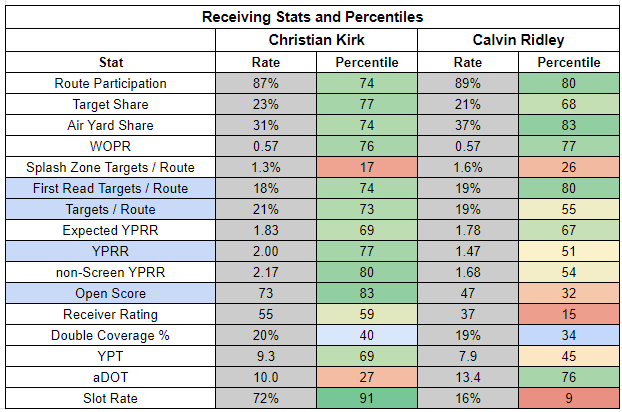
Kirk also looks like a slightly better fit for a matchup where time to throw could be an issue. With a 10.0 aDOT he’s a safer bet for targets than Calvin Ridley, who has a deep 13.4 aDOT. It’s also worth noting that defenses aren’t really trying to take Ridley away. He has a very low 19% double coverage rate. So although the Titans don’t double cover at a very high rate, that may not help Ridley much. Kirk profiles as a WR2, with Ridley as a FLEX.
Even after last week’s 4/12/0 stinker, Evan Engram profiles as a solid TE1 play. He is getting open at a very high rate and should be a good fit for this matchup with an ultra-shallow 3.7 aDOT.
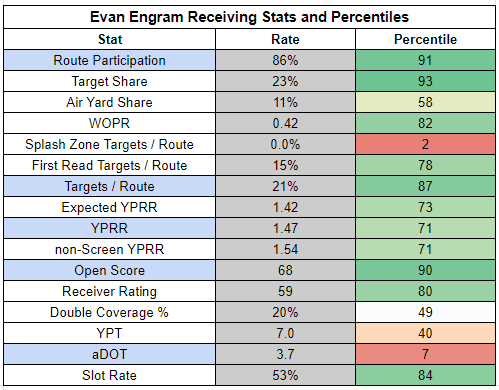
If the Jaguars can play from ahead as 7-point home favorites, Travis E tienne should see plenty of work against a middling Titans run defense.

Etienne has mostly been a bet on an elite workload. But he’s been a bit like Josh Jacobs last year, combining good efficiency with great usage. Although, in fairness to Jacobs’ 2022 season, Eitenne’s good efficiency has been less as an efficient yardage creator and more as a TD scorer. Still, he profiles as locked-in RB1 here.
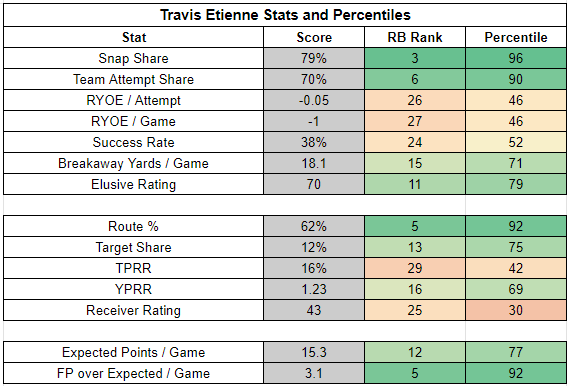
Buccaneers at 49ers, 4:05 PM
Buccaneers Implied Team Total: 14.75
Baker Mayfield is having a remarkable bounce-back season. After looking like a backup-level QB in 2022, he’s up to QB10 in EPA per game.

But it looks dangerous to assume that Mayfield will sustain this level of efficiency going forward. He’s just QB22 in success rate, just behind Aidan O’Connell.
And Mayfield gets a harrowing matchup with a 49ers pass defense that is elite at getting to the passer and in coverage.

The Buccaneers are pass-protecting pretty well, so they should be able to handle the 49ers’ pass rush to some extent. The bigger issue is what happens after Mayfield releases the ball from a clean pocket. The Buccaneers rank just 26th in EPA per dropback from a clean pocket and are facing a secondary that ranks third in PFF’s coverage grades. Mayfield may get more clean pocket opportunities than most quarterbacks do when facing the 49ers, but that doesn’t mean he won’t make mistakes.
And Mayfield could be dropping back a lot. The 49ers are better against the pass than the run, yet they have become a major pass funnel, as teams know they need to score points against the 49ers to have a chance at winning.

The Buccaneers are not an especially aggressive team. As we saw against the Bills, they’re not above playing for a comfortable loss rather than pressing for a win. But at the same time, the Buccaneers are not as stubbornly committed to a run-heavy approach as an extreme team like the Falcons are. They may fight game script a bit, but they’ll generally pass when the situation calls for it.

With the 49ers’ high-end pass rush getting after Baker Mayfield, this may seem like a poor setup for Mike Evans, who has a very deep 14.9 aDOT. But Evans has seen 57% of his targets come via quick throws (2.5 seconds or less). Chris Godwin is only at 54%. This highlights the impact of Evans’ much higher first-read target rate. Evans’ routes take longer to develop than Godwin’s. But Mayfield is more frequently looking Evans’ way first. This helps save time. Evans remains a WR1 in this matchup, with Godwin profiling as a low-end WR2.

Cade Otton looks viable as a garbage time bet. The tight end is running routes at a very high rate. He’s not doing much else… but if you need a cheap option, he’s not completely off the radar.

The 49ers are somewhat weak against the run, ranking just 27th in EPA allowed per rush. However, they rank 19th in rushing success rate and 16th in run stop win rate, so they’re more middling in run defense than bad. The trouble for the Buccaneers is that they have been very inefficient at moving the ball on the ground, ranking dead last in EPA per rush and rushing success rate. They’re best off if they follow the established game plan against the 49ers by playing aggressively.

This would also be best for Rachaad White’s fantasy value. White has been extremely unexplosive as a rusher, ranking RB48 in RYOE per game and RB42 in breakaway yards per game. But he’s been very impressive in the receiving game, ranking RB12 in YPRR and RB1 in receiver rating. The more passing the better.

Although White isn’t adding much burst in the running game, he’s been borderline reliable on the ground, with a 38% success rate. That should keep him involved in short-yardage and goal-line situations. He’s a solid RB2.
49ers Implied Team Total: 26.75
The 49ers are coming off a 34-3 demolition of the Jaguars, and all of a sudden, the Brock Purdy hate has quieted. That’s as it should be… it never made any sense to be so critical of a QB who has had exactly one bad game this season.

Purdy’s numbers are juiced. Let’s get that out of the way. I never bought into Jimmy Garoppolo as anything close to an elite QB when he was with the 49ers. And just because Purdy ranks QB1 in EPA per game and QB1 in success rate, he's not the best QB in the NFL… but he does lead the NFL in those predictive metrics.
To a large extent, he’s playing point guard in the most point guard-friendly system in sports. But the dude is one hell of a point guard.

Purdy now gets a Buccaneers defense that is both not good and especially vulnerable to the 49ers’ style of attack. The Buccaneers rank dead last in protecting the splash zone and are allowing 15+ yard passes at the fourth-highest rate. Meanwhile, the 49ers are generating explosive passes at the highest rate in the NFL and only the Texans are generating more efficiency by attacking the deep middle of the field.
Moreover, the Buccaneers don’t have a good pass rush. They rank just 25th in ESPN's pass rush win rate and 25th in quick pressure rate. This is immensely good news for Purdy, who has had to deal with quite a bit of pressure this year. The 49ers rank 22nd in pass block win rate and 31st in quick pressure rate.
Purdy has also had to deal with a lot of blitzes. The 49ers face extra rushers at the highest rate in the NFL. And the Buccaneers will bring the heat; they rank third in blitz rate. But the Bucs are not a very effective blitzing team, ranking 22nd in EPA allowed on blitzed dropbacks. All in all, the Buccaneers have the exact weaknesses that Kyle Shanahan is designing his offense to exploit.

49ers targets can be difficult to predict, but there is no doubt that Brandon Aiyuk leads the way on downfield targets over the middle of the field. Aiyuk leads the NFL with a splash zone target rate of 9.2%. He and Tyreek Hill (8.5%) are the only players above 6%. And fittingly, the next two highest players are another 49er and Dolphin: Jaylen Waddle (5.8%) and Jauan Jennings (5.3%). Aiyuk isn’t seeing targets in the splash zone by happenstance—it’s what the offense is designed to do.
And Aiyuk is excelling in this role. Only Keenan Allen ranks higher in ESPN’s open score. And only Tyreek Hill (3.95) has a higher YPRR than Aiyuk’s 3.11.
To top it all off, the Buccaneers are double-teaming WRs at the fifth-lowest rate. Aiyuk is in a near-perfect spot for his skill set. If the 49ers lean into this matchup, his ceiling is astronomical.

George Kittle is always a risky bet with Deebo Samuel in the lineup. But this looks like an exceptional big-play setup. Like Aiyuk, Kittle attacks the splash zone at a high rate, gets open at an elite rate, and delivers elite efficiency. It’s very plausible the 49ers aren’t pushed enough to fully unleash Kittle, but he’s a great efficiency bet in this matchup.

Samuel’s outlook is a little less exciting, but he’s also a highly skilled WR with rushing ability on a team with a 26.75 team total. He’s a locked-in WR2.

The major concern for 49ers receivers is that there may not be a ton of passing volume this week. The Buccaneers are unlikely to push the 49ers, and although the Buccaneers rank first in EPA allowed per rush, the other advanced metrics paint them as an exploitable run defense.

And the 49ers have a clear identity when playing from ahead. They establish the run.

Fortunately, the Buccaneers have been so bad at defending the pass, that they have become a major pass funnel. The 49ers may still opt for their typical run-first approach, but there’s quite a bit of upside here if they follow the established game plan.

Christian McCaffrey has spoiled us. It’s wild that a 20.3 PPR outing can go down as genuinely disappointing. But it’s hard not to feel let down by McCaffrey’s TD-less performance against the Jaguars.
McCaffrey now gets another overrated run defense and should be in another high-scoring offensive outing, even if the Buccaneers are as thoroughly shut down on offense as the Jaguars. As always, he’s an elite RB1.

Jets at Bills, 4:25 PM
Jets Implied Team Total: 16.25
One of these teams fired their offensive coordinator last week… and it’s not the guy who captained this:

Zach Wilson is coming off a game where he tossed a game-sealing interception. And yet, it qualifies as one of his best games of the season. This simply cannot continue. Zach Wilson is not a starting-level NFL QB.

Oh, and Wilson never has been a starting-level QB. Since Wilson entered the NFL, no QB has a lower success rate and only Bryce Young has been less efficient. (Raise all the red flags on Young).

A quick examination of both charts above will reveal the horrifying truth. As bad as Zach Wilson was in his first two seasons… he’s been significantly worse this year. From 2021-2022, Wilson averaged -6.5 EPA per game. He’s averaging -9.5 EPA per game this season. To be fair, Wilson is in a Nathaniel Hackett offense and regularly interacts with Aaron Rodgers. I’m almost surprised he hasn’t been worse.
In fairness to Hackett, he called a sensible game against the Raiders. The Jets were balanced overall but posted a 12% PROE on 1st-and-10. This set up Wilson for an efficient outing, and as bad as he was, he did have one of his best games of the year.

Mercifully, Wilson now faces a Bills pass defense that injuries have turned into one of the worst in the league.

The Bills should be capable of pressuring Wilson, who plays behind the NFL’s 26th-ranked offensive line in pass block win rate. But Wilson’s biggest issues have been from a clean pocket. And this matchup gives him at least a moderate chance of being mediocre, rather than terrible.
That’s great news for Garrett Wilson, who continues to shine. Wilson ranks WR3 in open score, behind only Keenan Allen and Brandon Aiyuk. He’s an emerging superstar. QB play is a powerful thing, though. Wilson looks like a high-end WR2 here.

Zach Wilson is also holding Breece Hall back in a major way. Hall has been a highly explosive rusher and receiver, but defenses are fully aware that the Jets would rather have the ball in his hands than Zach Wilson’s, which contributes to Hall’s very poor 32% success rate. Hall’s inconsistency isn’t entirely on him, but either way, he’s developed into a very boom/bust bet.

Fittingly, the Bills have been a boom/bust run defense. They rank 10th in rushing success rate but just 19th in EPA allowed per rush.

It’s more of the same here with Hall. He’s an RB1, but one who will need to save a frustrating day with big plays. The thing is, he is talented enough where that’s actually bankable.
Bills Implied Team Total: 23.25
Following their embarrassing loss to the Broncos, I get why the Bills fired Ken Dorsey. It’s hard to excuse this kind of passing performance against a Broncos defense that remains exploitable.

But Dorsey's firing still largely looks like a Sean McDermott scapegoat play, unless Dorsey has also been directing the Bills’ discombobulated and mismanaged defense. Josh Allen has had his struggles this season, but it’s not easy to achieve this level of passing efficiency.

By sheer variance, things should swing Buffalo’s way a bit more. But the Bills could be quite a bit worse under a new offensive coordinator. Because, regardless of how it feels, Josh Allen has been highly efficient this year.
Passing volume is one obvious area of concern going forward. Somehow, the narrative around the Bills’ loss to the Broncos includes the idea that they didn’t run enough. In reality, the Bills ran far more than expected. Buffalo had a 61% expected pass rate against the Broncos but posted just a 53% pass rate.

And the Bills were very conservative on 1st down, with a -9% PROE.

Playing like this makes embarrassing upsets more likely, not less. But we could see a more conservative version of the Bills going forward, given the narratives around Dorsey’s offense.
And in Joe Brady’s first game as offensive coordinator, he gets a Jets defense that has been a major run funnel.

The Jets aren’t bad against the run, though. They’re just not scary good against it.

By contrast, the Jets are scary good against the pass, pairing a high-end pass rush with a PFF’s top-ranked coverage. We could see a run-heavy Bills game plan for the second straight week.

Normally, this would be great news for a RB with James Cook’s efficiency profile. Cook has been an explosive and highly consistent rusher with added value in the passing game. He looks like a high-end RB1 with true lead back usage.

But… we should not expect true lead back usage for Cook—far from it. Cook is coming off just a 48% snap share and 48% carry share against the Broncos and hasn’t seen an inside-the-5 carry in six straight games. The would-be RB1 is an RB2 efficiency bet.

The Jets are effectively limiting first-read targets this season, but even still, Stefon Diggs should be productive. He is the clear focal point of the Bills passing attack. And that should remain the case regardless of the offensive coordinator.

Things are harder to predict at the No. 2 and No. 3 WR spots. Khalil Shakir has been between 70%-75% route participation over the last three weeks, while Gabe Davis has been between 91%-98%. So Davis is a lock for more routes. But Davis is drawing targets infrequently enough that he’s reduced to a boom/bust FLEX. Shakir is a desperation-only option in this matchup.
Fortunately, Dalton Kincaid provides a reliable secondary option. This matchup isn’t great for Kincaid, given the Jets’ coverage abilities. But he could also benefit if the Bills deploy a quick passing game. Kincaid has an ultra-shallow 4.6 aDOT, but is getting open at a high rate, and is drawing targets. He was billed as the Bills version of Travis Kelce. Instead, he’s their version of Evan Engram. But Evan Engram on the Bills is still a TE1 profile.
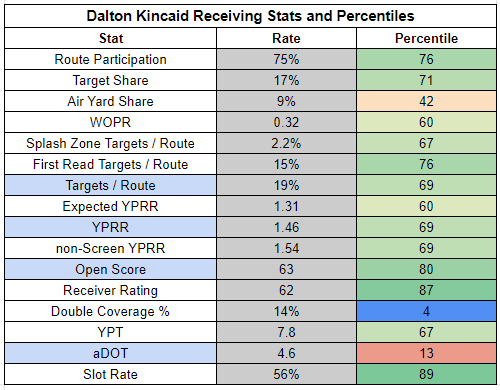
Seahawks at Rams, 4:25 PM
Seahawks Implied Team Total: 23.75
Geno Smith is coming off one of his better games of the season against the Commanders. He didn’t take full advantage of a great matchup but managed strong efficiency and consistency.

Smith continues to profile as a positive regression candidate, ranking QB8 in success rate but just QB22 in EPA per game

And Smith now gets a matchup with a Rams pass defense that has been very poor in coverage. Los Angeles ranks dead last in coverage grade and isn’t taking away the opposition’s first read.

However, the Rams are double-teaming WRs at the fourth-highest rate this season, so both DK Metcalf and Tyler Lockett should be expected to see a lot of defensive attention. That will make the target distribution difficult to pin down, especially with Jaxon Smith-Njigba seeing more playing time in recent weeks.
Still, Metcalf and Lockett remain a cut above JSN. The rookie logged just 64% route participation last week and has hit a 30% air yard share just once. Metcalf has hit 30%+ in 6-of-8 games, with Lockett at 8-of-9. Smith-Njigba’s mini-emergence makes Metcalf and Lockett harder to rely on but this is still their offense.

It’s not just target share we need to worry about here, though. Overall passing volume is a concern. The Rams are a run funnel.

The Rams aren’t terrible against the run, just mediocre. But teams are still choosing to test them frequently. And the Seahawks’ ground game is effective.

Still, we shouldn’t expect the Seahawks to get carried away here. With a 2% PROE and a 6% PROE on 1st-and-10, they are a firmly pass-first team.

This is actually good news for Zach Charbonnet, who is beginning to profile as a true passing down specialist.

Coming off a five-target game, Charbonnet is a viable RB2 punt. But Kenneth Walker will still handle the vast majority of carries. Even last week, Walker handled 76% of carries and he’s at 71% for the season. And Walker is breaking tackles and providing long runs.

Unfortunately, Walker isn’t doing much else beyond that. He’s a highly inconsistent runner and is delivering fewer yards than expected, per NFL Next Gen. Increasingly, Walker is dependent on early-down rushing work. He profiles as a TD / big play-dependent RB2.
Rams Implied Team Total: 22.75
In an absolutely brutal year for QB injuries, it’s nice to see Matthew Stafford return from his Week 8 UCL sprain. Stafford only ranks QB17 in EPA per game and QB25 in success rate, but he still represents a massive upgrade from Brett Rypien.

Stafford’s return should be especially helpful against a solid Seahawks defense that is generating pressure and effectively limiting first-read throws.

Pressure is a major issue for the Rams this season. They rank 27th in pass block win rate and 27th in PFF’s pass block grades.
This could lead to a more conservative game plan for the Rams, which would also make sense in Stafford’s first game since injuring his thumb. Even before Stafford’s injury, the Rams were shifting to a more run-heavy approach as they struggled to consistently protect Stafford in the pocket.

We actually saw Royce Freeman take the lead in carries against the Packers in Week 9, although he did so on only 38% of snaps. It’s possible the Rams turn things over to one RB after their bye week, but some sort of a split is most likely.

But if we get any hints of things moving toward Darrell Henderson or Freeman this week, they aren’t crazy dart throws. The Seahawks haven’t been great against the run this year, and rushing volume could be decently high in this matchup.

When Stafford drops back, we’re likely to see a heavy dose of the quick passing game as a means of mitigating Seattle’s pass rush. This sets up well for Cooper Kupp, who will be Stafford’s first look most frequently. As the clear focal point of the offense, Kupp profiles as a WR1.
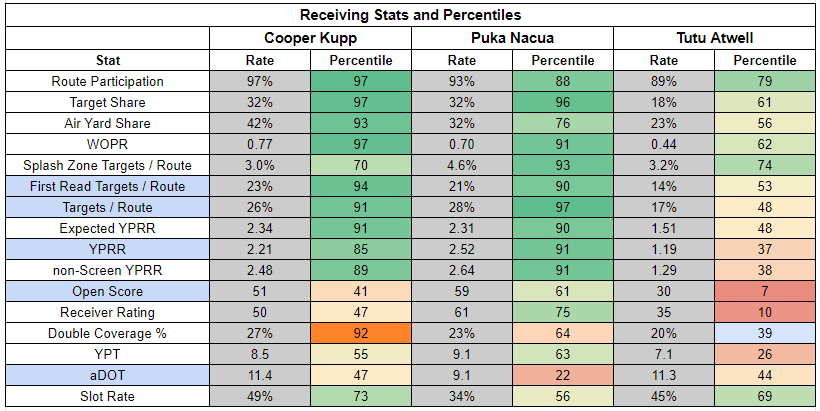
Puka Nacua’s 9.1 aDOT also sets him up for quick passes as well. He’s out-performing Kupp in YPRR and open score; the rookie continues to impress. But with the Rams’ game plan likely to feature Kupp, Nacua is a WR2.
Tutu Atwell is a shaky bet in this matchup. He’s seeing first-read targets at a far lower rate than Kupp or Nacua and sees targets much deeper downfield than Nacua. He’s a dart throw FLEX.
Vikings at Broncos, 8:20 PM
Vikings Implied Team Total: 20
The Broncos have definitely gotten things together a bit on defense and – with all due respect to Josh Dobbs – the Vikings’ offense isn’t nearly as formidable without Kirk Cousins. That makes the usual matchup charts more difficult to trust.
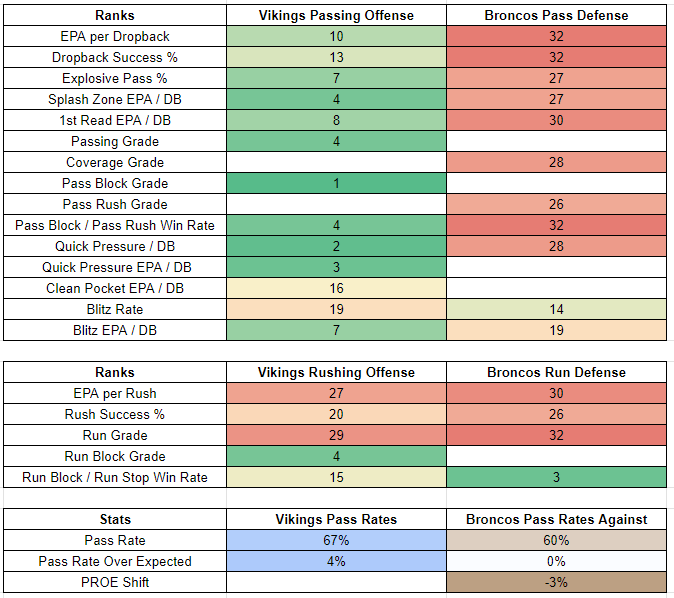
The pass rate data looks relevant, though. The Broncos have been a slight run funnel this season. And the Vikings have a history of playing balanced against teams that are unlikely to push them. Unless Russell Wilson plays very well this week, we’re unlikely to see an aggressive game plan from the Vikings.
Since Cousins was injured in Week 8, the Vikings haven’t been super conservative, but they are far less likely to take to the air like they did early in the season.
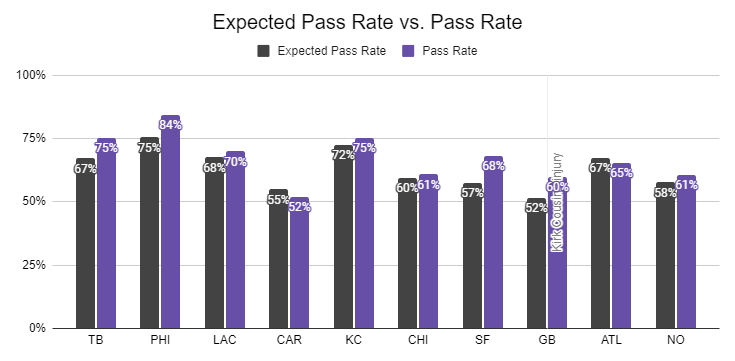
Passing volume is unlikely to be high here, but the Vikings have yet to fully hide their QB, and Josh Dobbs has played well enough for them to stick with a balanced game plan. Dobbs makes mistakes, but he’s also out there trying to make stuff happen. He’s in the Gardner Minshew zone.

Helpfully, target volume is highly concentrated and directed toward a tight end. Over the last two weeks, T.J. Hockenson has seen 26 targets for a ridiculous 39% target share. Hockenson has also seen 81% of his targets on first reads, indicating the offense has been designed to go through him. His floor is about as high as we ever see at tight end.

Jordan Addison is soaking up a lot of the remaining passing game volume, with a 21% target share over the last two weeks. His 11.4 aDOT also gives him big-play upside. He’s a solid FLEX option.
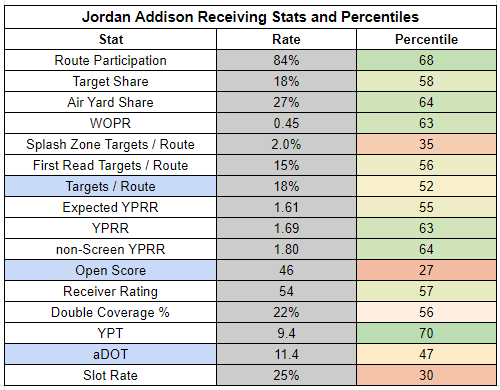
With Alexander Mattison expected to be out with a concussion, Ty Chandler should lead the backfield. As Ben Gretch notes, Chandler actually scored his TD last week before Mattison left the game, indicating the Vikings had a role planned for him. Chandler’s 2023 sample is small, but human eyes have reached a consensus here—Chandler is more explosive than Mattison. He’s a solid volume-based RB2 play here.
Broncos Implied Team Total: 22.5
The Broncos have won three straight. And during that stretch, Russell Wilson recovered from very poor play in Weeks 5-6. He’s been solid during this winning streak, but not especially impressive.

Sean Payton doesn’t appear to view Wilson as the engine of his offense. The Broncos have consistently leaned on the run over the last three weeks and have become increasingly run heavy.

This matchup doesn’t give Payton a reason to shift from his new offensive approach. The Vikings are a middling run defense and teams aren’t really shifting their approach against them.

With the Vikings’ offense unlikely to push the Broncos off a run-heavy approach, Javonte Williams is set up for a strong workload. Williams doesn’t have total control of the backfield. Against the Bills, he lost 34% of snaps to Samaje Perine, who mostly played a receiving role. He also lost 18% of carries to Jaleel McLaughlin. But Williams has still handled 62%+ of carries in each of the last three weeks. His workload is somewhat game script dependent, but this sets up as a good environment.
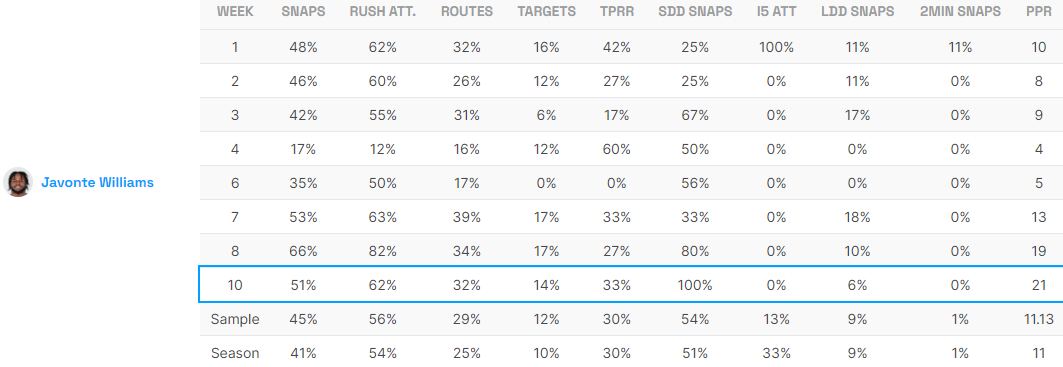
Williams hasn’t been super efficient this season, but he’s starting to flash in a couple of areas. Williams’ 44% success rate is very strong and reinforces the bet that he can operate as the Broncos' early down engine. Williams has also been an efficient receiver, indicating upside for more burst going forward. He profiles as a volume-based RB1.

Although Russell Wilson won’t be asked to shoulder the offensive attack, he should be capable of hitting some big plays and helping to convert third downs. He’s had an up-and-down season, but Wilson ranks a respectable QB13 in EPA per game and QB19 in success rate.
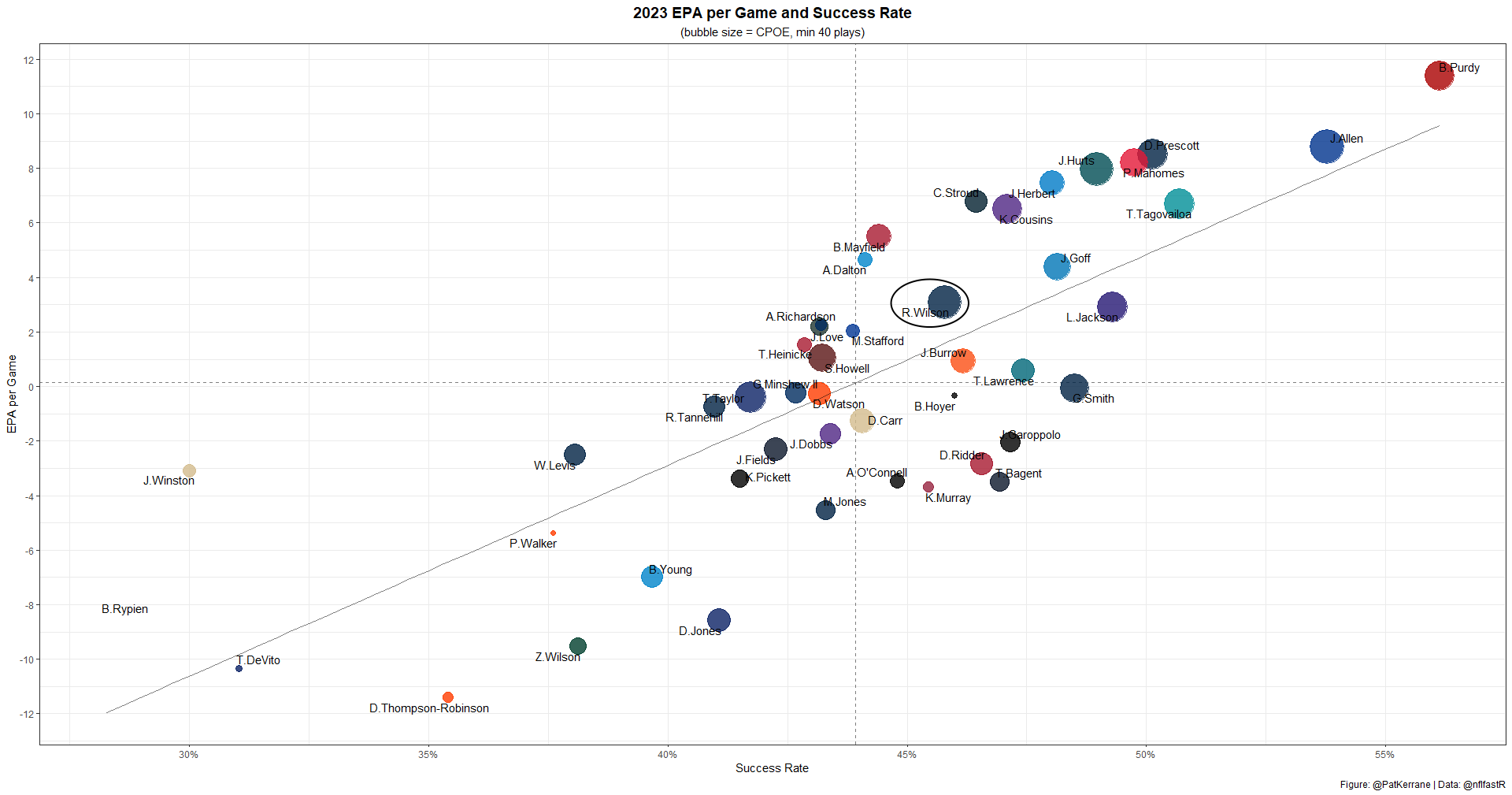
Wilson faces a Vikings defense that covers well but struggles to rush the passer, which it makes up for with a high volume of blitzes. Wilson has been blitzed in small doses this year and hasn’t handled it all that well. He’ll likely make some mistakes against this strong secondary.
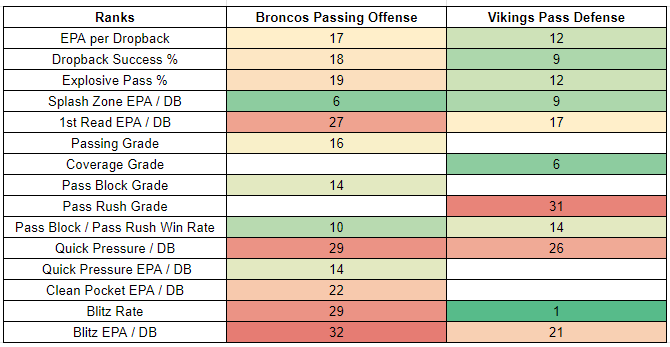
Wilson’s receivers have been uninspiring for most of the season, but things could get interesting this week. After not appearing on the injury report Wednesday, Jerry Jeudy popped up as a limited participant with a hip injury. His Friday status is critical.
Marvin Mims logged 76% route participation last week, which is an encouraging sign following the Broncos’ bye. However, he saw just one target. Mims’ profile remains very strong on a per-route basis but that is driven entirely by early-season production. He has a total of four receiving yards since Week 5.
However, if Jeudy misses this game or is limited, Mims’ playing time increase makes him a viable FLEX option. If Jeudy’s hip injury is a false alarm, Mims will mostly serve to make Sutton and Jeudy even shakier bets.
If Jeudy plays, Sutton’s 11-to-3 target lead last week overstates his lead in the target pecking order. Sutton remains a slightly better bet when both are healthy, but he’d still just be a FLEX. However, if Jeudy is out, Sutton gets the biggest boost. It’s fun to dream about Mims, but Sutton has an established connection with Wilson and is getting open at an impressive rate.

Eagles at Chiefs, 8:15 PM, Monday
Eagles Implied Team Total: 21.75
Back in the summer, when imagining the Eagles at Chiefs Monday Night Football matchup, I would not have expected to start with the Chiefs defense. But… we should probably start there.
The Chiefs have been elite against the pass, ranking third in EPA allowed per dropback and second in dropback success rate. They are also limiting big plays and taking away the opposition’s first read.
And only the Falcons are double-teaming WRs at a higher rate than the Chiefs this season. All in all, the Chiefs look like a team capable of interfering with the Eagles’ primary plan of attack—hitting A.J. Brown for explosive plays downfield.

However, the Chiefs do not have a good pass rush. And this could be a problem against Jalen Hurts. On throws from a clean pocket, Hurts is averaging 0.24 EPA per play. If Hurts was that efficient on all plays, he'd rank QB2 in EPA per play this season.
Although, regardless of whether or not he faces pressure, Hurts is playing very well. He ranks QB5 in EPA per game and QB7 in success rate.

We should fully expect Kansas City to concentrate on taking away A.J. Brown here. That fits with their usual approach and the Chiefs are fully aware of how the Eagles would prefer to attack.
But limiting first reads generally and limiting A.J. Brown are not the same thing.
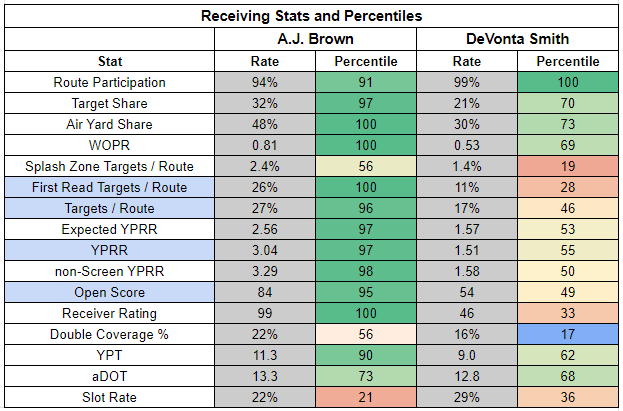
This matchup represents a downgrade for Brown, but he’s still an elite play.
Arguably, this matchup represents an upgrade for DeVonta Smith, who could see a fair amount of single coverage with the Chiefs focusing their attention on Brown. And if Hurts has time to throw, Smith’s concerningly low 11% first-read target rate should have less of an impact. He profiles as a WR2.
But if Hurts is struggling to connect with Brown, the most obvious pivot is to run the ball more. The Chiefs have been quite bad against the run, ranking just 30th in EPA per rush and 25th in rushing success rate. The Chiefs have been so bad against the run that teams are daring to shift slightly to the run against them. That’s not something we’d typically expect to see against a Patrick Mahomes-led team.
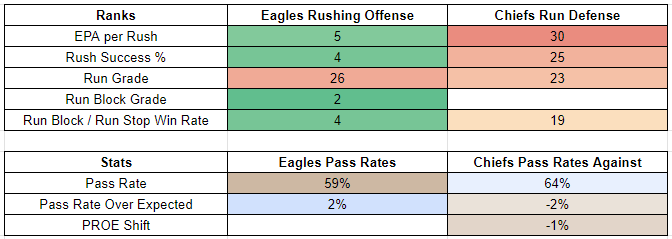
With a 2% PROE and an 11% PROE on 1st-and-10, the Eagles clearly see the passing game as their primary plan of attack.

I don’t anticipate the Eagles coming out of the gates with a run-heavy plan of attack. But it’s definitely something they could shift to if having trouble getting the offense going. And they could effectively salt away the game if able to get out to a big lead.
This gives D’Andre Swift a robust path to value this week. Even in scenarios where the Eagles passing game is clicking, he’ll be part of a high-scoring offense. As usual, he’ll be drawing dead for a TD any time the Eagles are on the one-yard line, but other than that, it’s a pretty strong setup. With a strong success rate this season, he looks capable of delivering on a solid workload against a weak run defense. Swift is a high-end RB2.

Chiefs Implied Team Total: 24.25
Patrick Mahomes followed up his letdown against the Broncos with a sneaky bad performance against the Dolphins. For the third time this season, he posted an EPA per play below the 50th percentile.

Then again, it says something about how good Mahomes normally is that a 45th percentile showing in EPA per play is concerning. Mahomes hasn’t been his usual in-his-own-tier self this season, but he’s still played excellently, ranking QB4 in EPA per game and QB5 in success rate.

And Mahomes now faces an Eagles defense that has an elite pass rush but is quite beatable in the secondary. This is a nice setup for Mahomes, who plays behind the NFL’s top-ranked offensive line in pass block win rate. The Eagles' pass rush will likely disrupt some key plays, but Mahomes’ WRs should be able to get open, which can sometimes be a major problem.
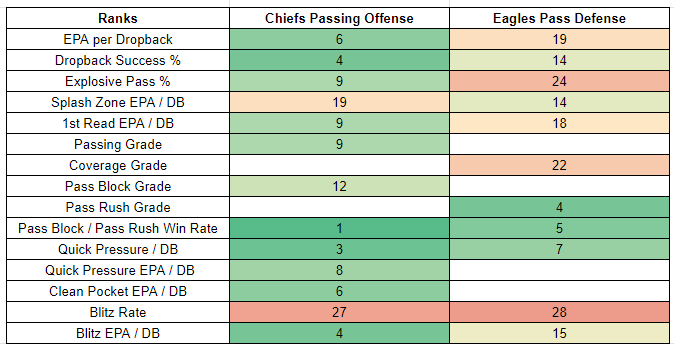
Mahomes is also set up for quite a bit of passing volume. The established game plan against the Eagles is to air it out. Teams don’t want to deal with a strong run defense and are averaging a ridiculous 75% pass rate, with a 6% PROE and a 4% shift to the pass.

This fits exactly with how Andy Reid likes to play it. With a 9% PROE and a 9% PROE on 1st down, the Chiefs are one of three teams that are fully committed to the pass.
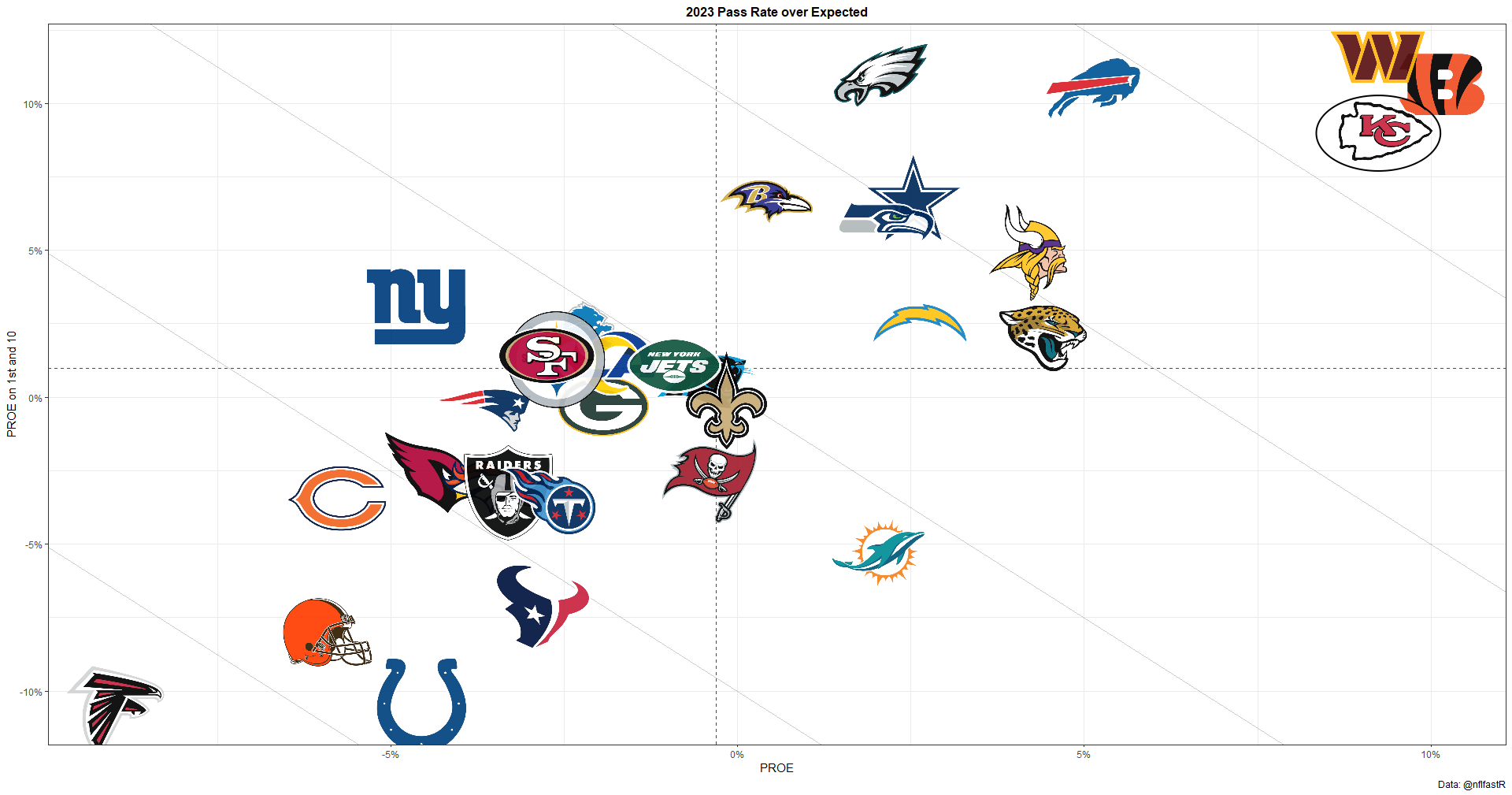
With the Chiefs coming off their bye, I’m willing to bet that we see a significantly increased role for Rashee Rice. Rice’s role was already growing prior to the bye, with four straight weeks between 50%-65% route participation. If we’re going to see Rice make a jump into the 75%+ range, this would be a logical week for it to happen.
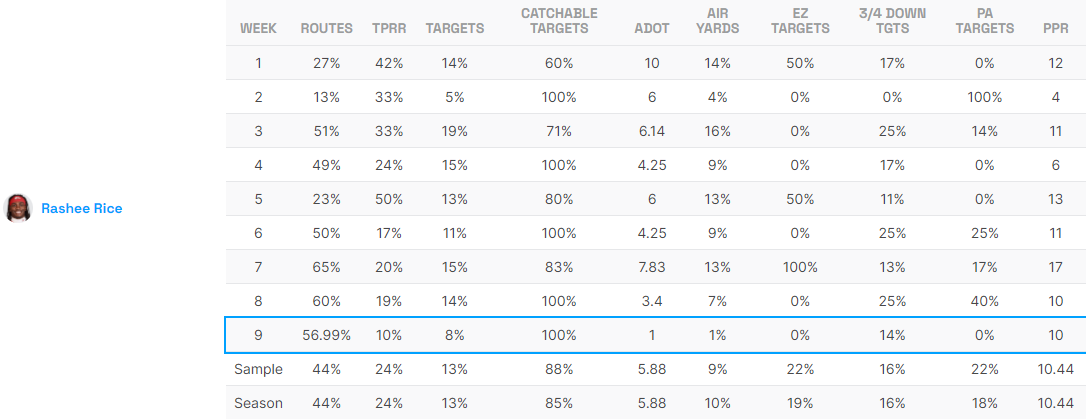
Rice has been extremely efficient this season, with a 2.28 YPRR. But honestly, he’s running hot. His 9.5 YPT is quite high for a player with a super shallow 5.9 aDOT. If his target volume remains similar, he’ll likely post good-not-great efficiency going forward.

But… this is the Chiefs’ WR room we’re talking about. Good-not-great efficiency on sizable route volume would be amazing. This is the status quo:

Of course, Travis Kelce remains the top option on the Chiefs and at the tight end position. He’s drawing targets at an elite rate for a WR, much less a tight end. And his ability to draw targets isn’t just a function of poor target competition. Only Mark Andrews ranks higher in open score.

In the backfield, we don’t have to hope for a playing time increase. We just need Isiah Pacheco to return to the role he flashed before the Chiefs’ bye.

Pacheco doesn’t have a great matchup, but he’s been solidly efficient across the board, is tied to Patrick Mahomes, and has access to a potentially elite touch share. He’s a locked-in RB2.

Edited by Nic Bodiford
PROE data for all 32 teams
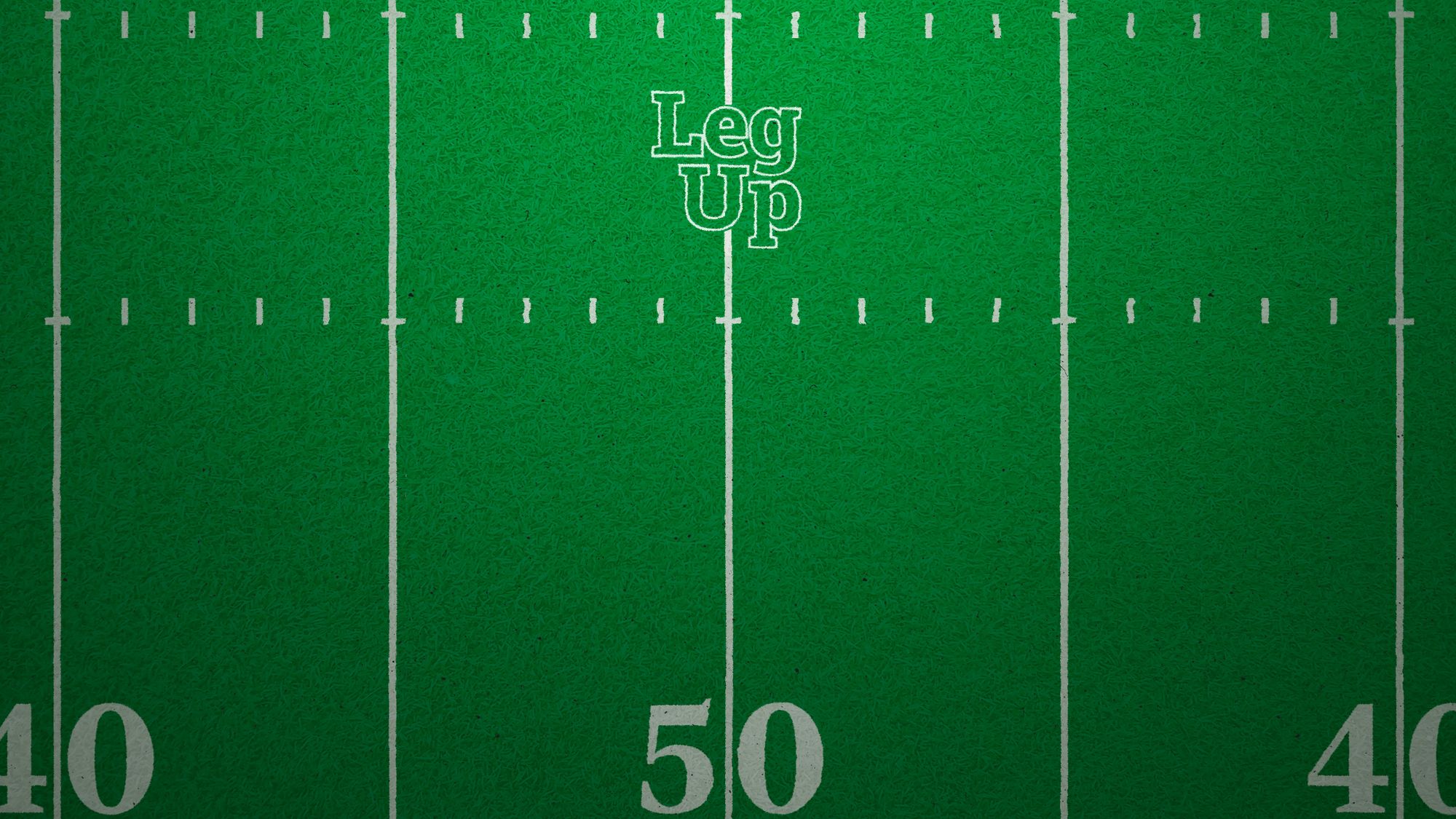
Full Newsletter Archive

Details on $50 Underdog Credit, 40% off Spike Week, Discord Access, Premium Podcast Feed


